
2024 Trek Slash
Wheel Size:
- Size Small: 27.5’’
- Sizes Medium through XL: 29’’ front / 27.5’’ rear (29’’ compatible)
Travel: 170 mm rear / 170 mm front
Geometry Highlights:
- Sizes offered: S, M, M/L, L, XL
- Headtube angle: 63.3° (Default setting, adjustable)
- Seat tube angle: ~77° (Varies by size and geometry setting)
- Reach: 488 mm (size Large)
- Chainstay length: 434 mm (size Large)
Frame Material: Aluminum and carbon fiber versions available
Price: Complete bikes: $4,400 to $11,500
Blister’s Measured Weight: 36.6 lb / 16.6 kg (Slash 9.8 GX, Large)
Reviewer: 6′, 170 lb / 183 cm, 77.1 kg
Test Duration: 3.5 months
Test Locations: Washington, British Columbia
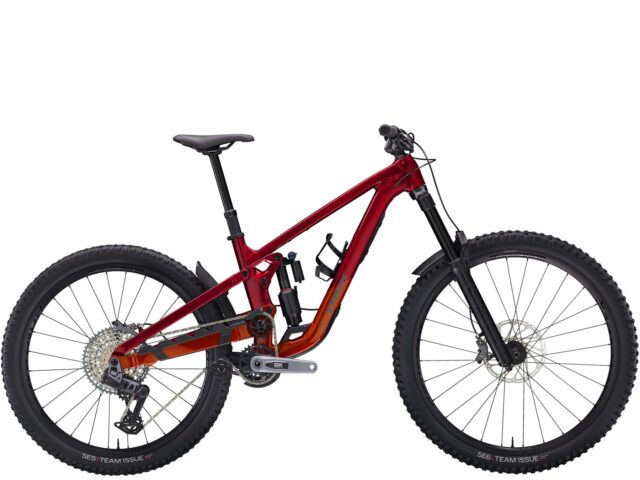
The Slash has been a longstanding part of Trek’s lineup — dating back to the days of 26’’ wheels — as their long-travel Trail model and eventually their Enduro race bike once that category emerged.
The fifth-generation Slash debuted a little over three years ago now, so it isn’t a big surprise that a new version has now surfaced. However, some of the new design details suggest it’s a more substantial update than simply “half a degree slacker here, a few millimeters longer there.”
The prior-generation Slash was arguably a touch conservative in some aspects of its design and geometry even back when it launched, but you’d be hard-pressed to say the same about the new sixth-generation bike — it’s gotten a big overhaul in just about every facet, and there’s a lot of interesting stuff going on here.
The Slash is now a 170mm-travel bike with a high-pivot layout — clear indications that it’s meant to be a big, gravity-oriented bike. But Trek makes it clear that they mean for the Slash to pedal well and climb efficiently, and say it’s intended to be confidence-inspiring for all sorts of riders on rugged descents, not a super game-on bike for only the hardest chargers out there. But what has Trek done to make that happen? Let’s check out the new Slash.
[And for a bunch more on the new Slash, including its design goals and how Trek went about achieving them, check out Ep.186 of our Bikes & Big Ideas Podcast with the lead engineer on the project, Matt Yerke.]

Like the fifth-generation Slash, the sixth-gen one is offered in your choice of an aluminum or carbon fiber frame, in sizes ranging from Small through XL with an ML snuck in the middle. It uses Trek’s longstanding ABP suspension layout — essentially a linkage-driven single pivot with a pivot between the chainstay and seatstay that’s located concentric to the dropout, to give a floating brake mount akin to a Horst link bike.
The big visual change is that the suspension layout has been reconfigured to feature a much higher main pivot, necessitating the use of an idler pulley to reign in the interaction between the rear suspension and chain forces, both in terms of anti-squat and pedal kickback. That idler pulley is on the larger side for high-pivot bikes (19 teeth) and is mounted to the chainstay substantially offset from the main pivot. This is in contrast to Trek’s Session DH bike, which mounts its idler concentric to the main pivot; that said, some of Trek’s athletes have been spotted riding what looks to be a prototype chainstay on the Session that moves the idler to a more Slash-like spot below and behind the main pivot.

Trek co-developed a lower chain guide specifically for high-pivot bikes, in collaboration with MRP, in order to increase chain wrap around the chainring, improve chain retention, and mitigate derailleur clutch movement (and in doing so, improve small-bump sensitivity from the suspension). That guide actually came out a while ago as the “MXg” and is designed specifically for high-pivot bikes such as the Slash. It includes an integrated bash guard and features a larger-than-average 14-tooth roller to reduce how much the chain has to flex, thereby keeping drivetrain drag to a minimum. It bolts to the lower two mounts of a set of ISCG-05 tabs (the Slash includes all three, though it’s not compatible with conventional upper chain guides due to the idler pulley); an integrated upper guide over the idler is included. The Slash is designed around a 55 mm chainline crank (as featured on SRAM’s new Transmission groupsets ) and uses a threaded bottom bracket shell. Despite the extra pair of pulleys, the Slash takes a standard 126-link chain in all sizes apart from the XL (which needs 128 links, due to its longer chainstays — more on those below).
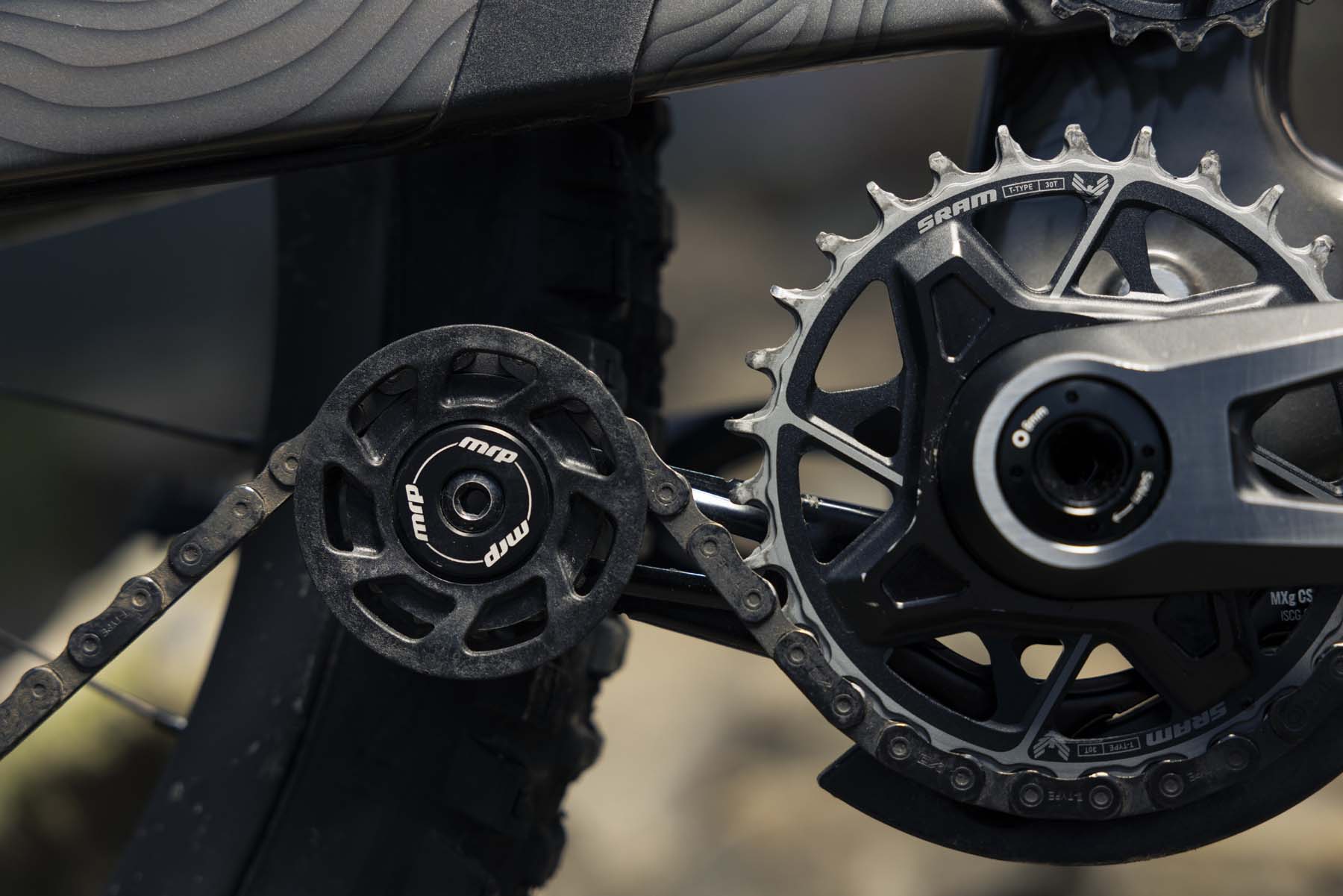
[It’s not labeled in this graph, but Trek says that the published numbers are in a 30/21 gear ratio, with the center of gravity sitting 800 mm above the bottom bracket.]
A flip chip in the sixth-gen Slash’s lower shock mount toggles between two different leverage curve settings, producing either ~20% or ~25% of progression in generally straight lines. A 230 x 65 mm shock produces 170 mm of rear wheel travel and the funky through-shaft shock used on the prior-generation Slash is no more, replaced by a standard RockShox Vivid on most of the complete builds (more on those below). Air shocks are spec’d throughout, but Trek says coils work just fine, too.
Speaking of the lower shock mount, it’s a bolt-on part that can be swapped to toggle between a 27.5’’ and 29’’ rear wheel on the size Medium through XL frames, paired with a 29’’ front wheel. The Small frame gets 27.5’’ wheels at both ends to keep the stack height in check for shorter folks. Interestingly, all the builds and sizes (Small excepted) come in the mixed-wheel configuration, only, with the 29’’ shock mounts sold separately for folks who want to make that conversion.
To round out the frame adjustability, Trek also offers offset angle-adjusting headset cups to toggle between three different headtube angle settings, as previously seen on the Fuel EX and Fuel EXe Al. Bikes ship with the neutral cups installed; the offset ones are available separately. The upper cup is a drop-in installation, but the lower one is a press-in affair.
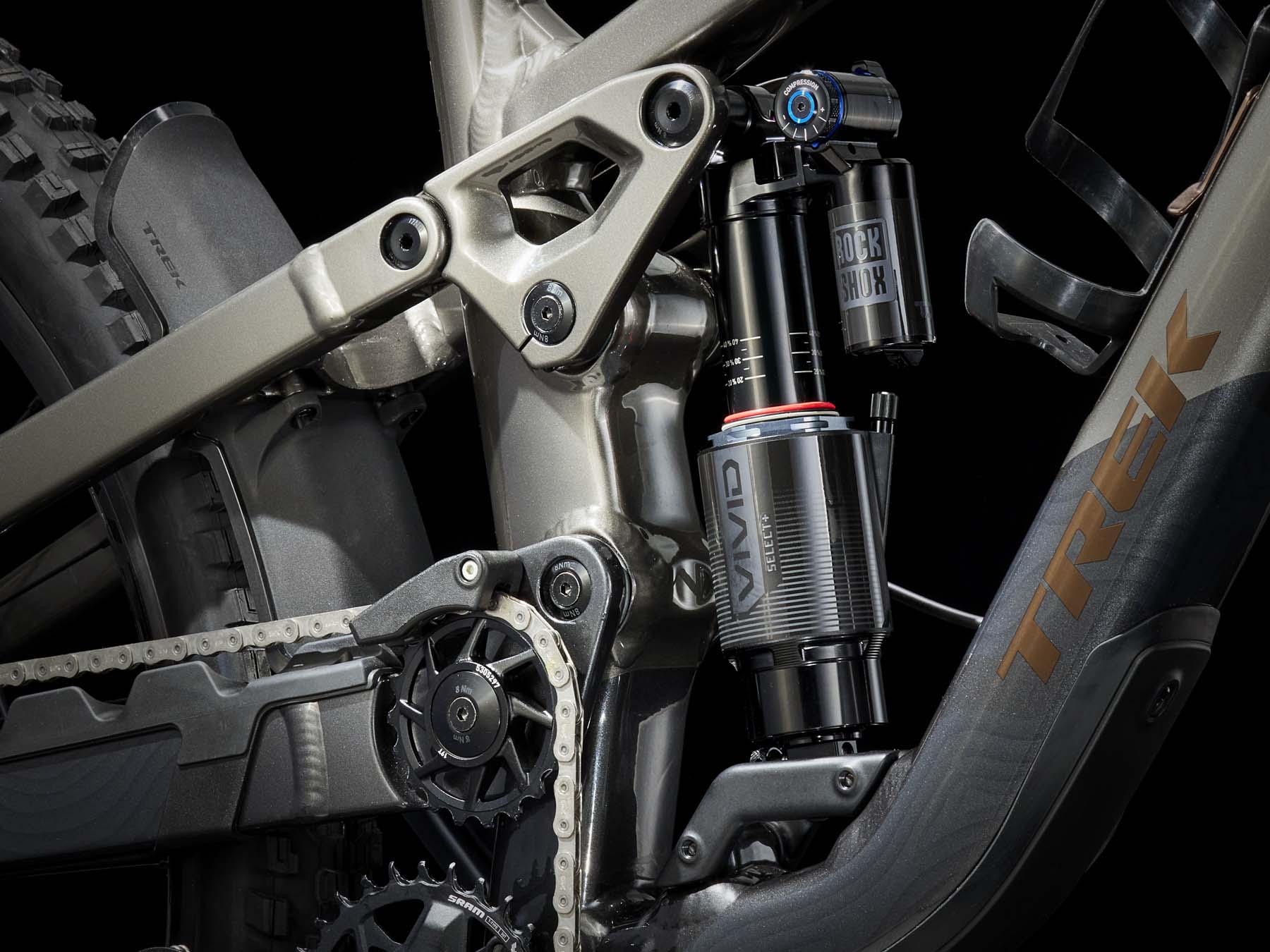
Trek was one of the first companies to offer in-frame storage on mountain bikes, and the new Slash continues the trend with a hatch under the water bottle mount on all frame sizes, in both the aluminum and carbon fiber frames. Cable routing is fully internal, with ports for the rear brake on both sides of the head tube, for folks who run their rear brake on the left side. The Slash features ample rubber guards on the chainstay, seatstay, and downtube, with the downtube guards bolting on for easy replacement should they get damaged. Trek says they’ve also applied a layer of an impact-resistant film underneath the paint on the carbon frames to further protect the frame from damage. A bolt-on rear fender is included as well, though Trek says it’s only compatible with a 27.5’’ rear wheel — there’s not enough clearance with a 29’’ one.
Trek specs the Slash with a 170mm-travel fork, but says that a single-crown fork up to 190 mm travel can be used if you want to go that route. Dual-crown forks, on the other hand, aren’t currently approved, though Trek says that they simply haven’t tested them enough to say for sure either way, so it’s possible they’ll be condoned at some point in the future. Trek has also done away with the Knock Block steering-limiting headset on the new Slash, and single-crown forks easily clear the downtube.
Fit & Geometry
Trek offers the Slash in five sizes, Small, Medium, ML, Large, and XL, with the reach ranging from 430 mm to 508 mm in roughly 20 mm increments. The headtube angle is 63.3° for the Medium frames on up (the Small steepens very fractionally to 63.5°). The effective seat tube angle is around 77° (varies slightly by size), with a still-pretty-steep 74° actual angle for the whole size range. There’s no kink in the seat tube on the new Slash, so dropper post insertion has been greatly improved — Trek says you can bottom a 200 mm post to the collar on a Medium frame. The chainstay lengths now vary by size, with the Small starting at 429 mm and the XL topping out at 439 mm; the Medium comes in at 429 mm, and the ML and Large share 434 mm stays.
All of those numbers are in the stock geometry configuration (i.e., neutral headset cup, mixed wheel sizes on Medium and larger sizes, dual-27.5’’ wheels on the Small). Going to a full 29’’ configuration on the sizes that support it steepens the headtube and seat tube by 0.2°, adds almost 6 mm to the chainstay length, and increases the reach by a couple of millimeters. Installing the offset headset cups either steepens the headtube angle by 0.8° or slackens it by 0.7° with fractional changes to the other geometry numbers.

[There’s a typo in Trek’s listed geometry charts, above — the reach on the XL frame in the mullet configuration should be 508.1 mm. And for the full range of charts, including with the offset headset options, check out Trek’s website.]
Those are really nice-looking numbers for a modern Enduro bike. If anything stands out as being a little bit unusual, it’s the fairly short chainstay lengths in the 27.5’’ rear-wheel settings. That said, it’s worth bearing in mind that the high-pivot layout and notably rearward axle path that it produces means that the Slash’s stays are substantially longer at sag, and continue to grow as it cycles deeper into the travel. That’s also why the chainstay length changes so much between the 27.5’’ and 29’’ rear-wheel configurations, and it’ll be interesting to see just how much the different rear-wheel options impact the ride of the Slash. We’ve got a set of the optional 29’’ rear wheel shock mounts for our test bike and will be finding out.
Trek offers the Slash in seven complete builds, with pricing ranging from $4,400 to $11,500. There’s a mix of SRAM and Shimano drivetrains in here, but apart from the entry-level Slash 8, all builds get some variant of a RockShox Vivid shock and ZEB fork (with the exact version varying by build tier). As per usual for Trek, builds with a whole number indicate aluminum frames, and “9.X” denotes a carbon one.

- Drivetrain: Shimano XT w/ Deore crank and SLX chain
- Brakes: Shimano Deore 4-piston
- Fork: Fox 36 Rhythm
- Shock: Fox Float X Performance
- Wheels: Bontrager Line Comp 30
- Dropper Post: Bontrager Line
- Drivetrain: SRAM GX Transmission
- Brakes: SRAM Code Bronze Stealth
- Fork: RockShox ZEB Select+
- Shock: RockShox Vivid Select+
- Drivetrain: Shimano XT
- Brakes: Shimano XT 4-piston
- Wheels: Bontrager Line Elite 30 Carbon
- Dropper Post: Bontrager Line Elite
- Drivetrain: SRAM X0 Transmission
- Brakes: SRAM Code Silver Stealth
- Fork: RockShox ZEB Ultimate
- Shock: RockShox Vivid Ultimate
- Wheels: Bontrager Line Pro 30 Carbon
- Dropper Post: RockShox Reverb AXS
- Drivetrain: Shimano XTR w/ e*thirteen LG1 Carbon crank
- Brakes: Shimano XTR 4-piston
- Drivetrain: SRAM XX Transmission
- Brakes: SRAM Code Ultimate Stealth
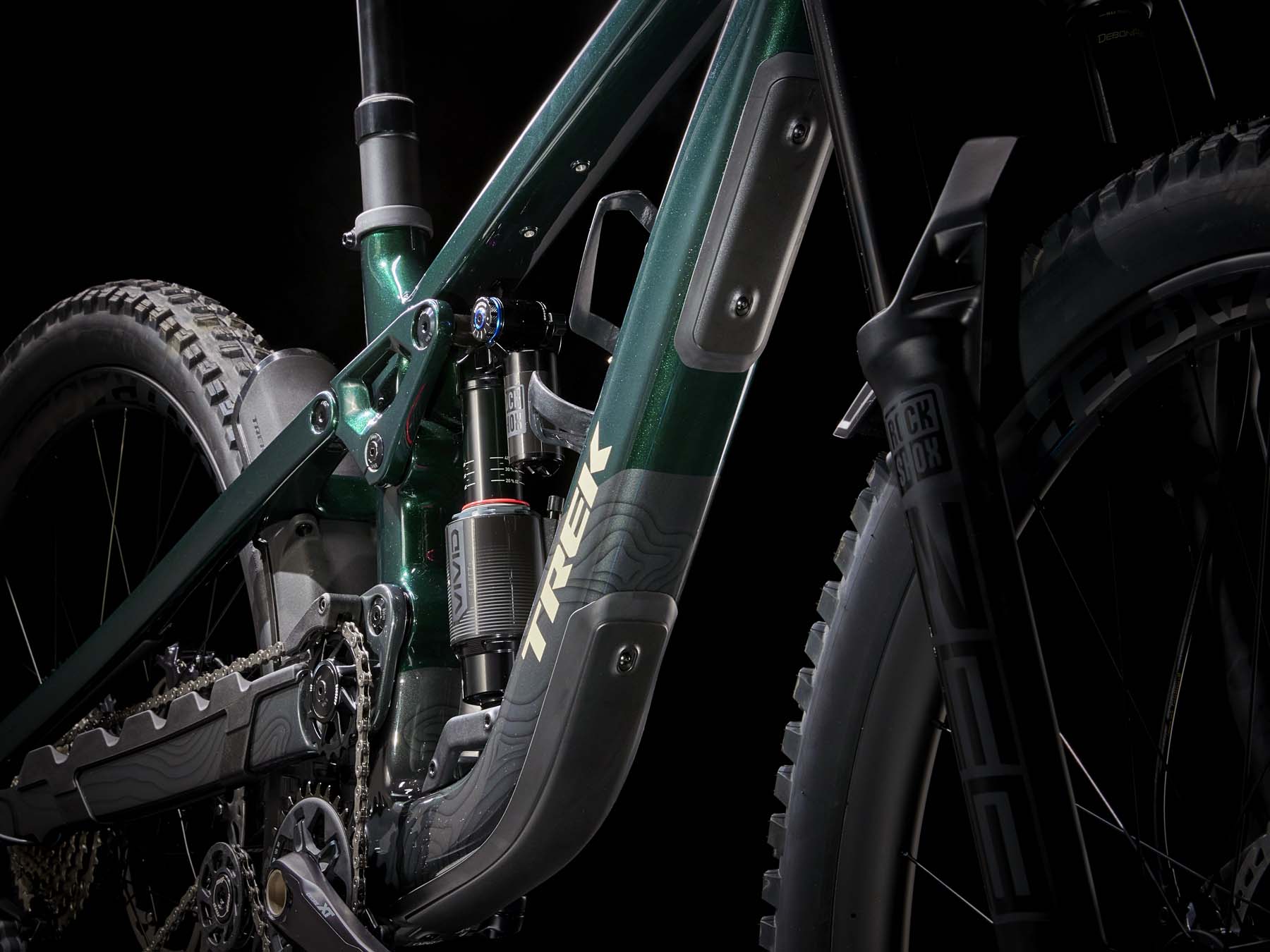
Some Questions / Things We’re Curious About
(1) The new Slash clearly looks to be a true, modern Enduro bike, with geometry and suspension numbers that should make it quite stable and composed at speed. But how versatile is the Slash, and how well does it pedal? Is it an ultra-planted sled of bike (a-la the Norco Range) or is it more well-rounded than that?
(2) How does the Slash stack up against many of the other high-pivot Enduro bikes that have been flooding the market of late, including the Norco Range , Forbidden Dreadnought , Nicolai Nucleon 16 , Cannondale Jekyll , Kavenz VHP 16 , Contra MC , and more?
Bottom Line (For Now)
Trek’s first high-pivot non-DH bike has been a long time in the making — check out Ep. 186 of Bikes & Big Ideas for a lot more on that, including how Trek considered making the Fuel EX a high-pivot. But it’s finally here, and the new Slash looks to be a compelling take on the genre. We’ve already been spending a lot of time on the Slash and will be logging a lot more miles on it in the months to come — stay tuned for our full review.
Flash Review
Blister Members can read our Flash Review of the Trek Slash for our initial on-trail impressions. Become a Blister Member now to check out this and all of our Flash Reviews , plus get exclusive deals and discounts on gear, and personalized gear recommendations from us.
FULL REVIEW
On paper, the new Trek Slash looks like one of the more emphatically descending-oriented Enduro bikes out there, with 170 mm of travel at both ends and a high-pivot layout derived from their Session DH bike .
We’ve been spending a lot of the summer and fall on the new Slash, and it is indeed very stable, composed, and confidence-inspiring when going very fast on steep, rough trails. But is it just a big bruiser of a bike, or is it more versatile than its numbers might suggest? And how does it stack up against a bunch of the other Enduro bikes out there? The answers are pretty interesting.
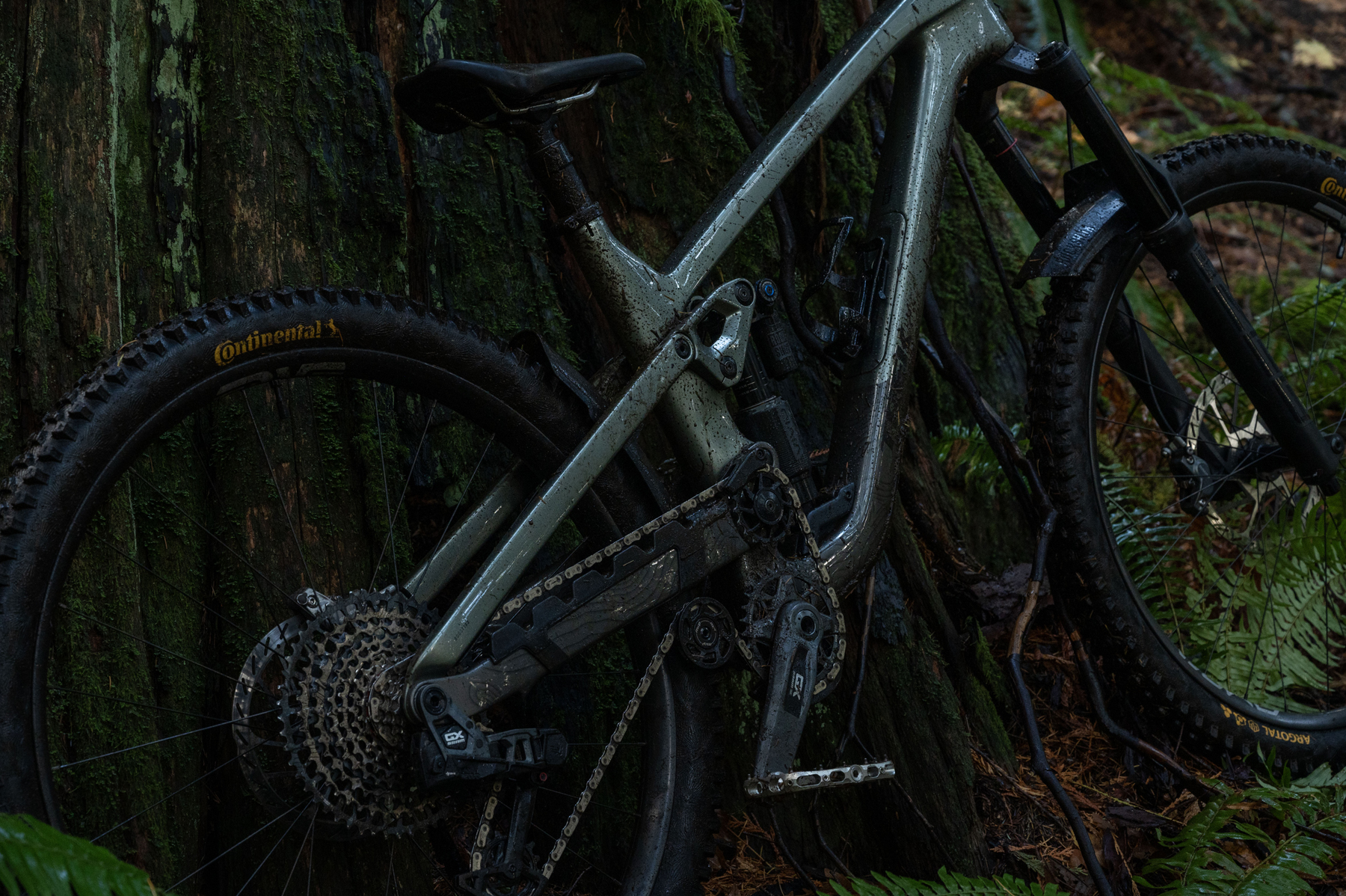
Fit & Sizing
Trek’s recommended sizing for the Slash puts me (6’ / 183 cm) squarely in the middle of the sizing band for the Large frame and outside of the overlapping regions for the M/L and XL sizes. That feels pretty on the money — I had an easy time getting comfortable on the Large Slash and wasn’t ever tempted to deviate from that size. If I were to make any changes to the Slash’s fit I might be tempted to bump up the stack height a little bit. Fortunately, the fork’s steerer tube came cut long enough to allow a hefty stack of spacers, and I wound up swapping out the stock bar for ride-quality reasons anyway (more on that in a minute); a 30 mm rise one suited me nicely.
The Slash’s seat tube is fairly steep (about 77° effective / 74° actual) and the pedaling position feels moderately compact relative to the roomy ~490 mm reach — pretty typical for a modern Enduro bike, but not to the point of feeling awkward on flatter climbs or anything like that.
I honestly don’t have a ton to say here — the Slash fits and feels pretty normal for a modern Enduro bike, and I mean that as a compliment. I had an easy time getting comfortable on it, without anything quirky or surprising going on. And given its relatively small 20 mm steps in reach between sizes, most folks should be able to find a size that works for them.
The Slash is a long-travel high-pivot bike, and even with its carbon fiber frame, carbon wheels, and not-super-heavy tires, our size Large Slash 9.8 GX review bike weighs in at 36.6 lb / 16.6 kg without pedals. Given that, I didn’t have the highest expectations for the Slash’s climbing performance when I first threw a leg over it, but it easily cleared the low bar I’d set in my head — the Slash pedals quite well for what it is. As is the case with pretty much every other ~170mm-travel Enduro bike out there, the Slash isn’t particularly interested in climbing quickly, relative to most shorter-travel “Trail” bikes, but if you’re okay with taking things a little easier and spinning (rather than sprinting) your way to the top, the Slash is impressively efficient.
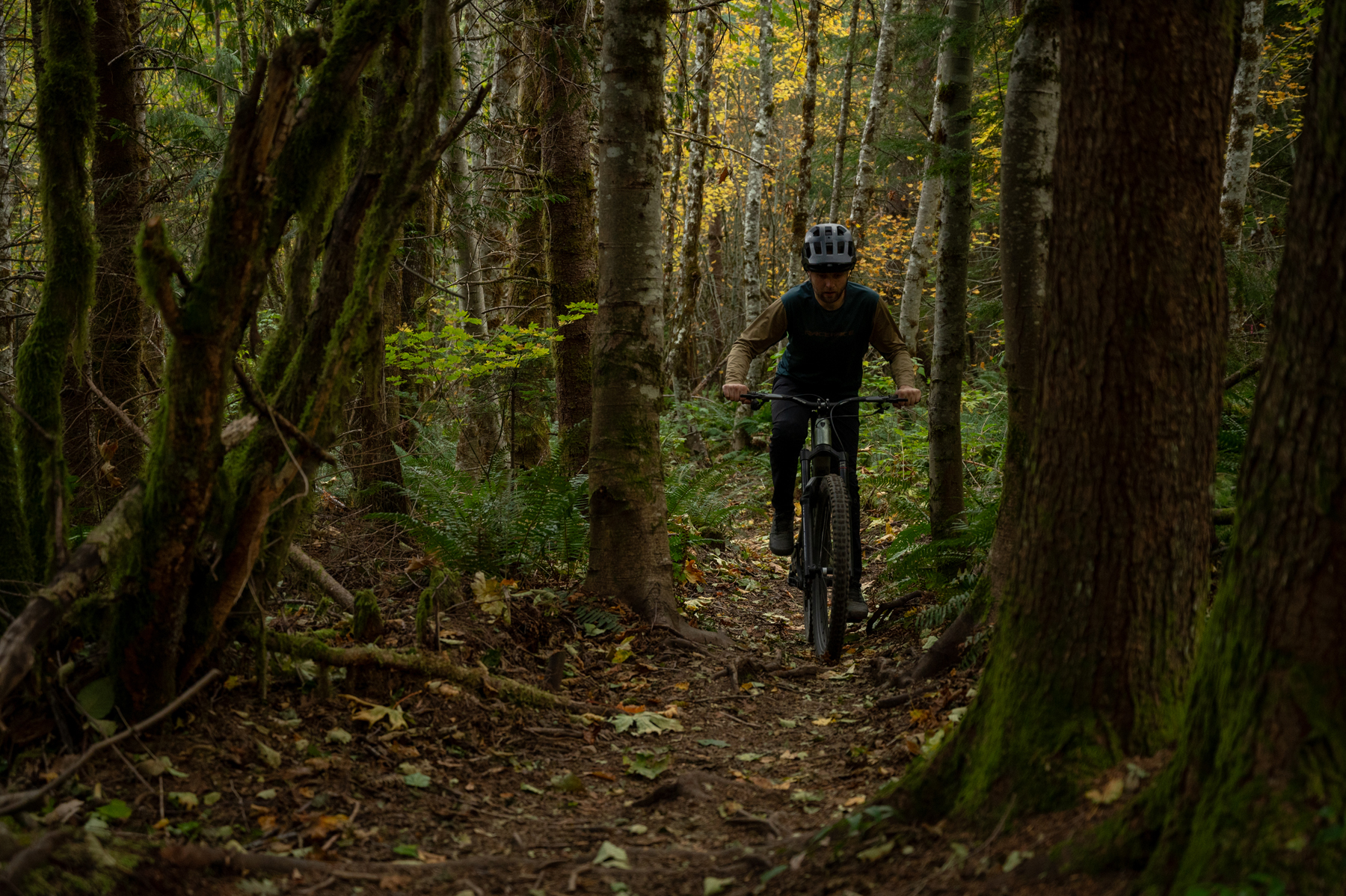
Even with the shock’s climb switch open, there’s not a ton of suspension movement under power, so long as you keep your pedal stroke reasonably smooth. The quite-firm climb switch on the RockShox Vivid adds a very solid platform if you want it. I found myself mostly not bothering with the climb switch very often — the Slash genuinely pedals quite well without it, and I found the loss of traction and comfort to rarely be worth the modest increase in efficiency. That said, I like the combination of a bike that doesn’t need a climb switch and a shock with a notably firm climb setting for the times you really want to eke out every bit of efficiency. I’m a big fan of how the Slash pedals.
As per usual for high-pivot bikes, the Slash does feel like its drivetrain efficiency falls off more quickly as the chain gets dirty and poorly lubed, relative to most bikes with a more conventional drivetrain layout. But provided that the chain isn’t too horrendously gritty and/or dry, the added drag from the extra couple of pulleys on the Slash feels modest. Straight out of the box, there was a bit of noticeable extra noise from the main idler pulley under pedaling, but that quieted down after a ride or two as things wore in, and the overall amount of drag from the Slash’s drivetrain feels very manageable.
The Slash is also a pretty good technical climber, especially from the standpoint of combining solid pedaling efficiency with very good rear-wheel traction under power. As is generally the case with long, low, slack bikes, the Slash can feel like a lot of bike to maneuver through rough, tight, ledge-y sorts of climbs, but it doesn’t feel unduly tough to manage in those circumstances — it just is a long, slack bike, and the tradeoffs there are typical of bikes with geometry numbers like that of the Slash. When things get really tight and awkward, a shorter-travel, more nimble bike is going to be easier to manage, but for the sorts of climbs where the main challenge is simply maintaining rear-wheel traction and keeping momentum, the Slash does quite well.

Especially in the stock mixed-wheel-size configuration, I did find myself wanting a bigger chainring than the stock 30-tooth one — the 30 x 52 low gear combination, paired with a 27.5’’ rear wheel, felt too low to be useful in most circumstances, and on some of the steeper climbs around here, I found myself wanting a gear between first and second. It would, of course, be an easy fix to swap in a larger chainring if you end up feeling similarly, though I (at least partially) solved the issue by swapping in a 29’’ rear wheel for much of my time on the Slash — a setup that I wound up personally preferring mostly for handling reasons, as I’ll describe in more detail below.
While the Slash does a commendable job of getting to the top under human power, it’s a bike that’s meant for the trip back down. So:
The Slash is, unsurprisingly, quite composed and confidence-inspiring when it comes to riding steep, technical trails at speed. It’s stable and planted without being so glued to the ground that it’s all that difficult to “get light” on and skip over holes and rougher bits. It also carries speed quite well when given enough pitch and space to let the bike run a bit. None of that should come as a surprise for a 170mm-travel high-pivot bike. However, the Slash does an especially good job of doing all that smash-y big-bike stuff while also being impressively intuitive and comparatively manageable in slower, tighter spots and/or when you’re taking things easier.
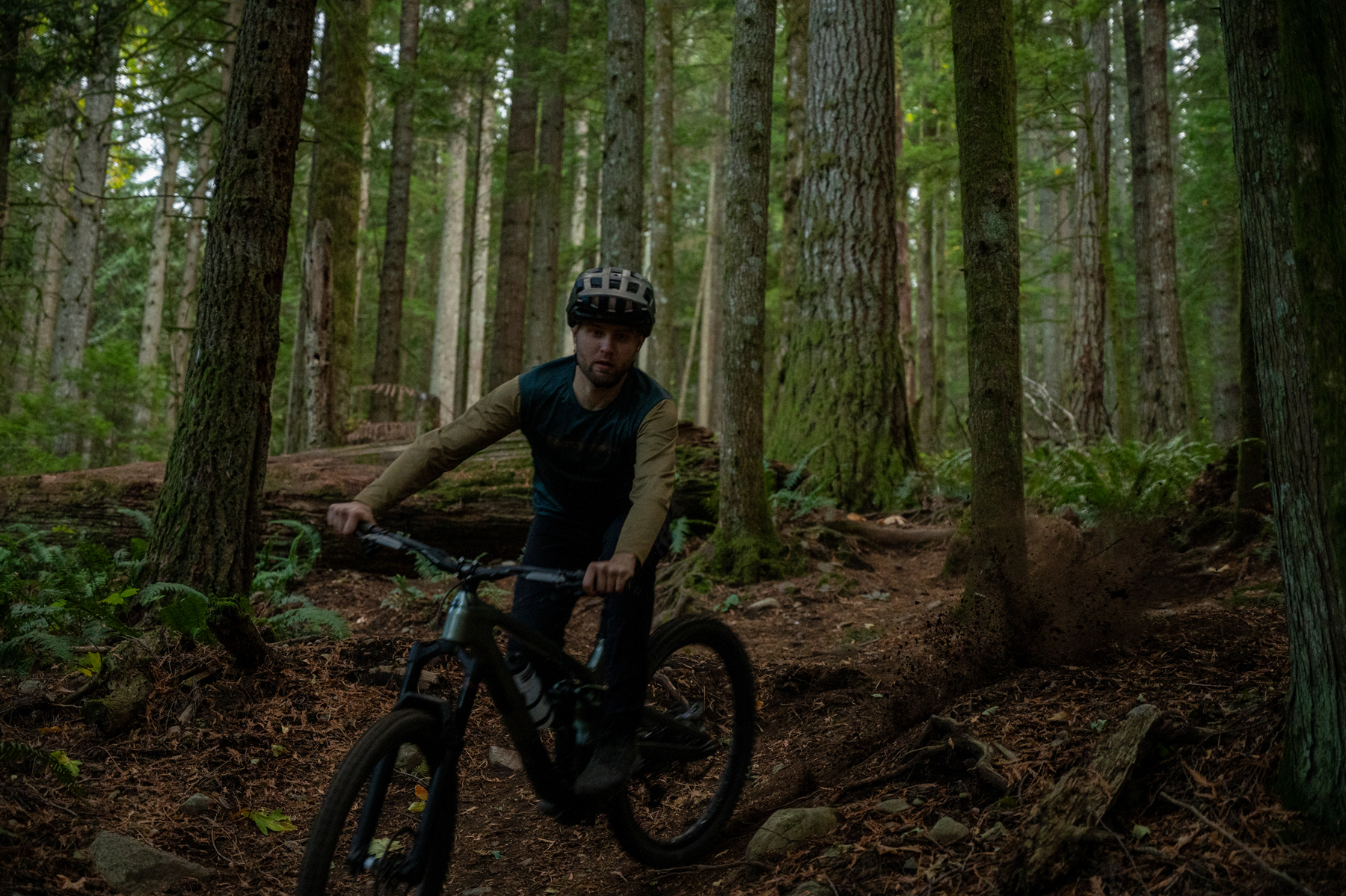
Of course, that’s all relative — the Slash is a long, slack, bike, and it’s not going to trick you into thinking you’re on a much more nimble, shorter-travel one when things get tight and awkward. But the Slash is very consistent and predictable, and that goes a long way toward making it easy to manage in a wide range of situations. The Slash’s braking performance is quite neutral, and it doesn’t have the same kinds of handling quirks that some bikes with ultra-rearward axle paths can display as the rear center (and therefore the balance point on the bike) changes wildly though the travel (e.g., the Forbidden Dreadnought ). The Slash is generally just very, very intuitive in both its handling and suspension performance.
Not needing to translate and react to what the bike is doing simply makes the Slash easy to get on and go, whether you’re flat-out charging or just want to have an easier time while riding steep, difficult trails. As with pretty much every bike in this sort of travel range, I wouldn’t recommend the Slash if you’re not going to be taking it down steep, technical descents on the regular. But for what it is, the Slash is pretty versatile, both in terms of the sorts of riders who I can see getting along with it, and in that feels more manageable than a lot of other similarly composed, stable bikes when you’re not going flat out.
The Slash also does a relatively good job of still being able to maintain speed by pumping — not a strong suit of high-pivot bikes in general — and otherwise facilitating a more dynamic, active riding style for being as stable and composed as it is when you just want to let the bike plow. That “relatively” is important — we’re talking about a big, very stable bike after all, and if you’re after a truly lively, energetic ride, you’d be better off with something lighter, shorter-travel, and more compact. But the Slash is impressively well-rounded for what it is.
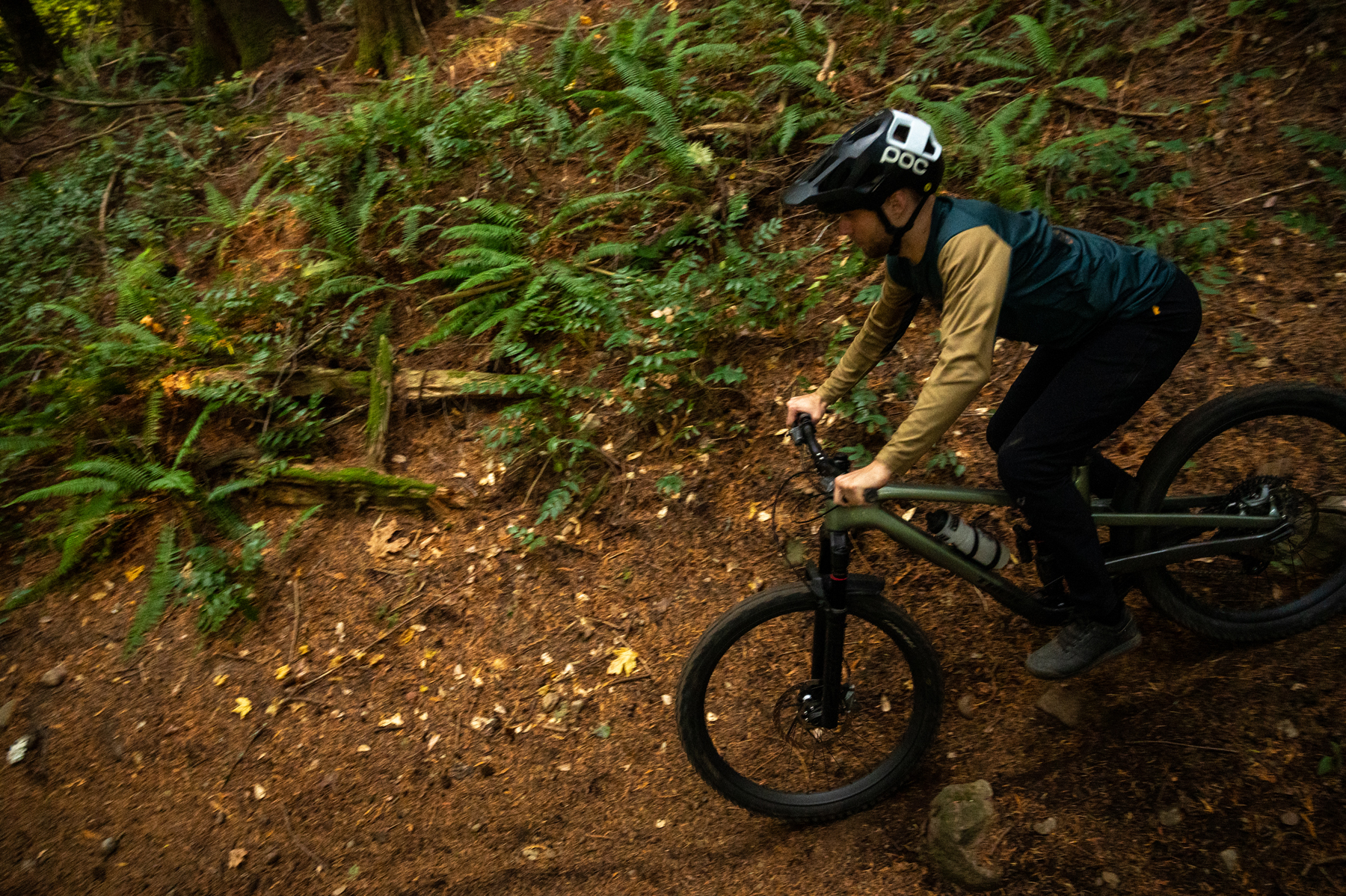
The fact that the Slash doesn’t feel exceptionally glued to the ground and eager to iron out every little bump probably helps in that regard. When you start going faster and hitting things harder, it is quite composed and confidence-inspiring in how it deals with bigger impacts and compressions, but isn’t exceptionally plush and cushy feeling on smaller chatter. It does a good job of maintaining traction on off-camber roots and the like, but does still transmit a bit of feedback about what the wheels are doing. Some bikes (e.g., the Norco Range ) iron out every bit of trail chatter more completely than the Slash. However, those bikes also tend to feel “dead,” less rewarding and energetic when loading them up to pop off something, and/or lack support through the middle part of the travel. The Slash hits a really nice middle ground there.
On that note, I found myself preferring the more progressive of the Slash’s two linkage settings; it offered improved bottom-out control and support deeper in the travel, especially when carrying speed into a really rough section of trail, where the lower progression setting felt slightly more prone to settling deeper in the travel and feeling slightly less balanced in how the bike used its front and rear travel. It’s not a stark difference by any stretch, and the lower progression setting feels plenty useable, especially for folks who want to make the Slash a little more supportive and lively in the beginning part of its travel. It’s easy to toggle back and forth, especially if you also loosen the two bolts that fasten the lower shock mount plates a turn to make aligning the shock hardware easier, and is worth experimenting with if you’re curious.
Wheel Sizes
Toggling between the Slash’s stock mullet wheel configuration and the optional full-29er setup doesn’t make for a massive change in the Slash’s character, either, but offers a relatively subtle twist on the same overall recipe in roughly the ways you’d expect. The smaller 27.5’’ rear wheel option makes the Slash a little quicker handling and correspondingly not quite as stable at speed, but I’d say the bigger difference is that it moves the Slash’s preferred balance point forward and biases it more toward being ridden with weight over the front wheel — bear in mind that the mixed-wheel configuration also shortens the chainstays considerably. The mixed-wheel setup also makes the back end quicker and easier to come around if you keep the front end weighted. The more you want to, well, slash and drift turns, the more the mullet configuration is likely to make sense; the 29er setup makes the Slash’s sweet spot feel bigger, especially if you’re riding it more centered and loading up the bike through the pedals in corners.
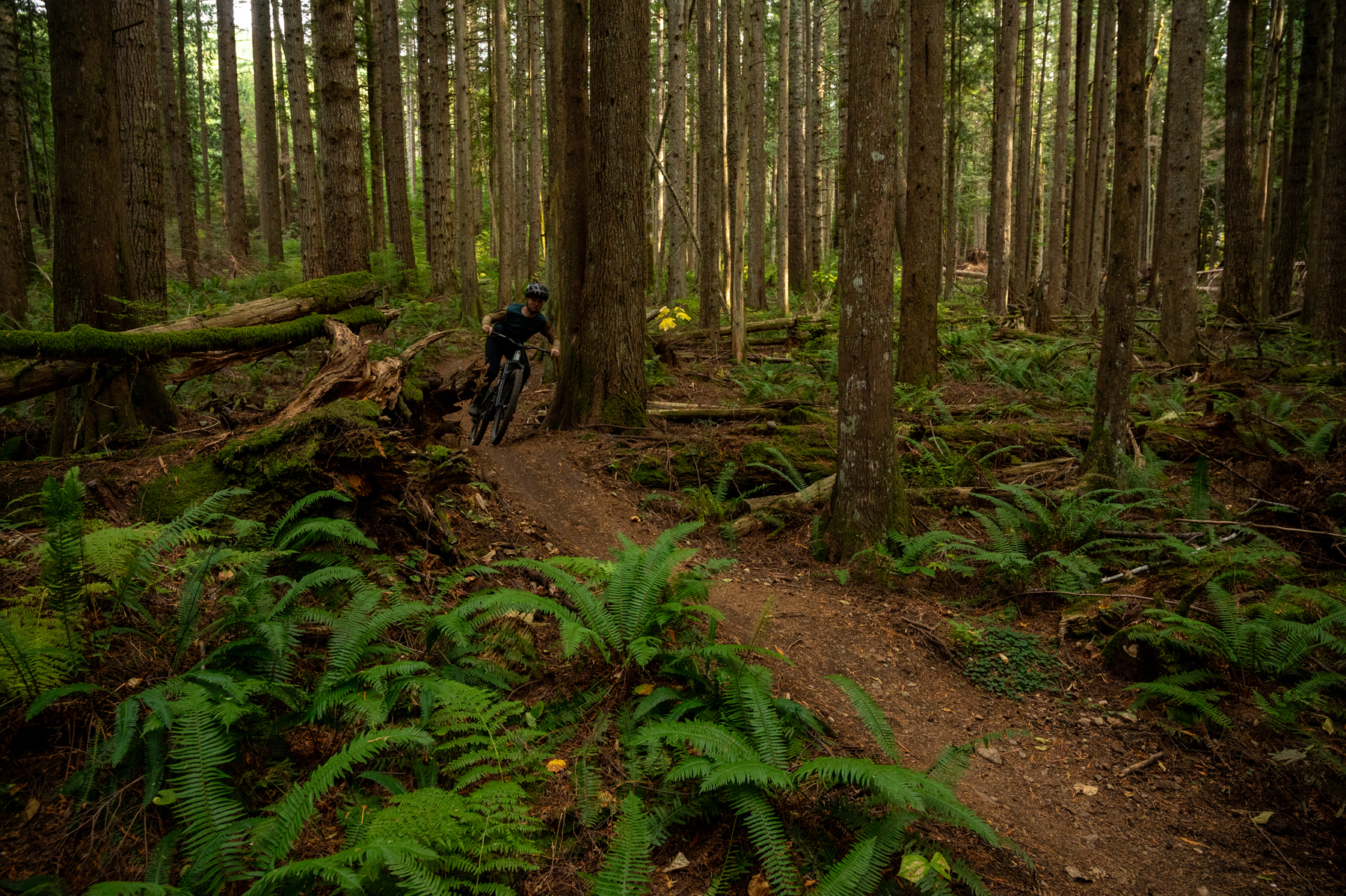
I found myself preferring the matched 29’’ wheels for that reason — they just give me a bigger platform to move around on the bike without upsetting its weight distribution between the wheels. As a result, they made it easier for me to push hard at speed. The mixed-wheel setup was more fun on trails where the Slash was borderline overkill and arguably makes it a little more versatile overall.
Still, the Slash is a big, descending-oriented bike that just happens to be a little more versatile than many other bikes that are similarly composed at speed in rough terrain, rather than a truly versatile all-rounder, so I found myself preferring to lean into what the Slash does best and emphasizing its stability and composure with the dual 29’’ setup. That said, I’m widely on record as not being the biggest fan of mixed-wheel bikes in general — especially those with shorter chainstays, and the Slash’s get substantially shorter in the mixed-wheel configuration. So that’s probably at least as much a confirmation of my general preferences as it is a reflection on the Slash itself.
The Slash’s frame (at least the carbon version; we haven’t been on the aluminum one) also feels very stiff overall, which has both pros and cons relative to some less stiff frames. Perhaps most interesting has been the Contra MC that I’ve been testing alongside the Slash (more on that below, and full review coming soon). The quite-stiff Slash frame feels notably precise and direct in how it responds to rider inputs, and very predictable when it comes to being able to feel how the rear wheel tracks through corners when there’s a lot of lateral load on the bike. The downside is that the Slash transmits more small chatter and feedback than a lot of less stiff frames (the MC being a particularly good example). The Slash’s suspension still provides good overall grip and does a nice job of maintaining traction on chattery, rooty sections, but it simply doesn’t feel quite as smooth or planted as I think it might if the frame was a bit less stiff.
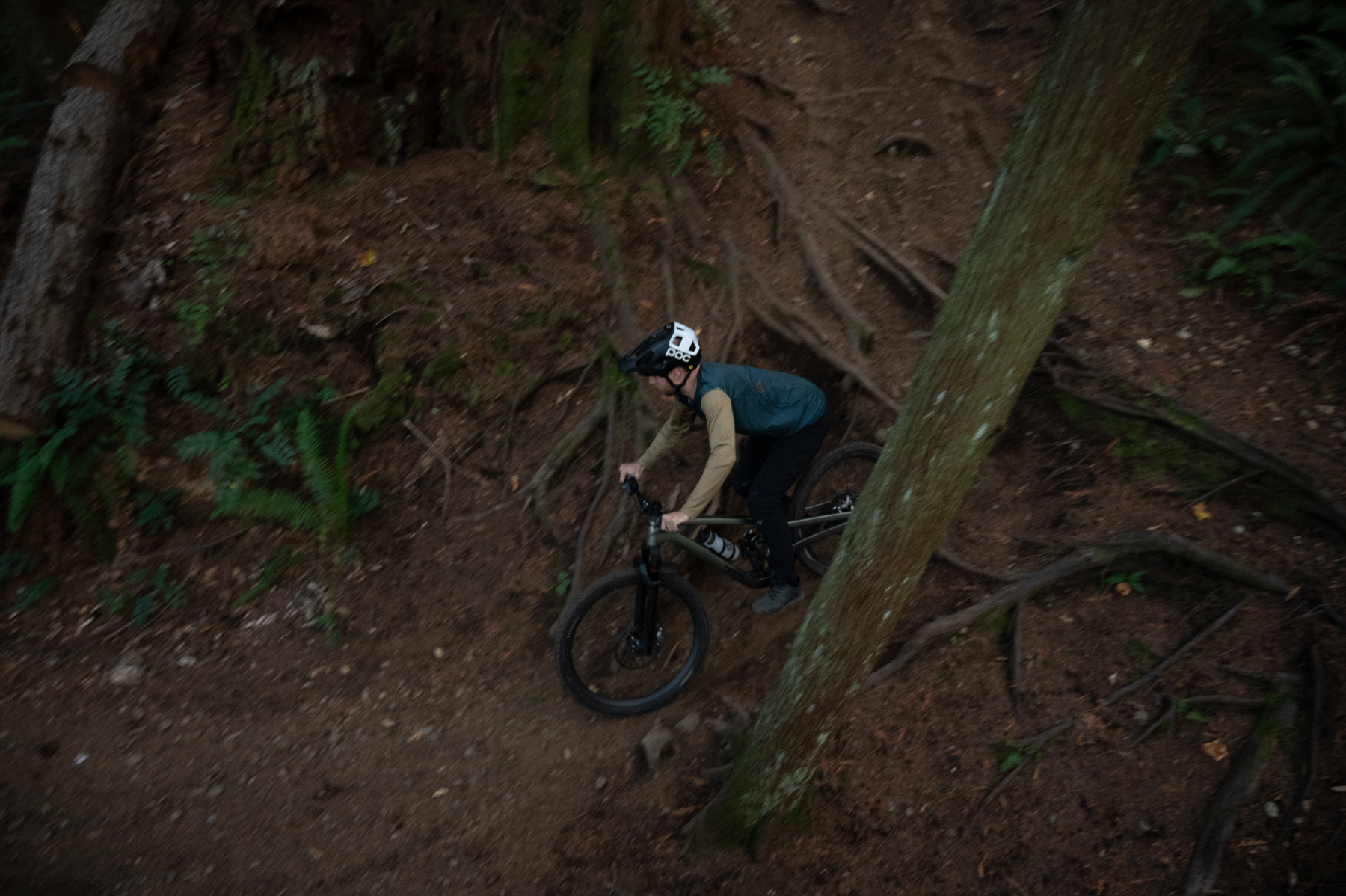
Chain Retention
And now for the elephant in the room. There’s been a lot of chatter across various corners of the internet about the Slash dropping chains left and right, and while I did drop the chain a few times over the course of my testing, it seems to be solvable, and ultimately a matter of chainguide setup. Here’s how it all went during my testing:
The Slash showed up as most review bikes do: mostly assembled, with the front wheel and handlebars removed in order to box up the whole thing. I started with the chainguide installed as it came from Trek; I dropped the chain off the underside of the chainring fairly quickly. The chainguide pulley looked like it was positioned pretty low, so I rotated it upward a bit, increasing the amount of chain wrap around the chainring, and everything was solid — no more dropped chains.
But then Trek sent a note saying they’d sent some early bikes out with the chainguide installed incorrectly, and things got a little more complicated. MRP, who make the lower guide, put together a document explaining how to set it up, with two main points: (1) there should be 7 mm of spacers between the ISCG tabs and the guide itself, to align the pulley with the chainring and (2) there should be a specified gap between the head of the chainguide mounting bolts and the end of the slot for them on the guide, setting the height for the pulley. Our bike showed up with 6 mm of spacers, and even after I’d previously clocked the guide upward, it was still quite a bit lower than MRP suggested, so I set everything up to their spec… and started dropping the chain a lot more regularly — this time off the inside of the pulley on the chainguide.
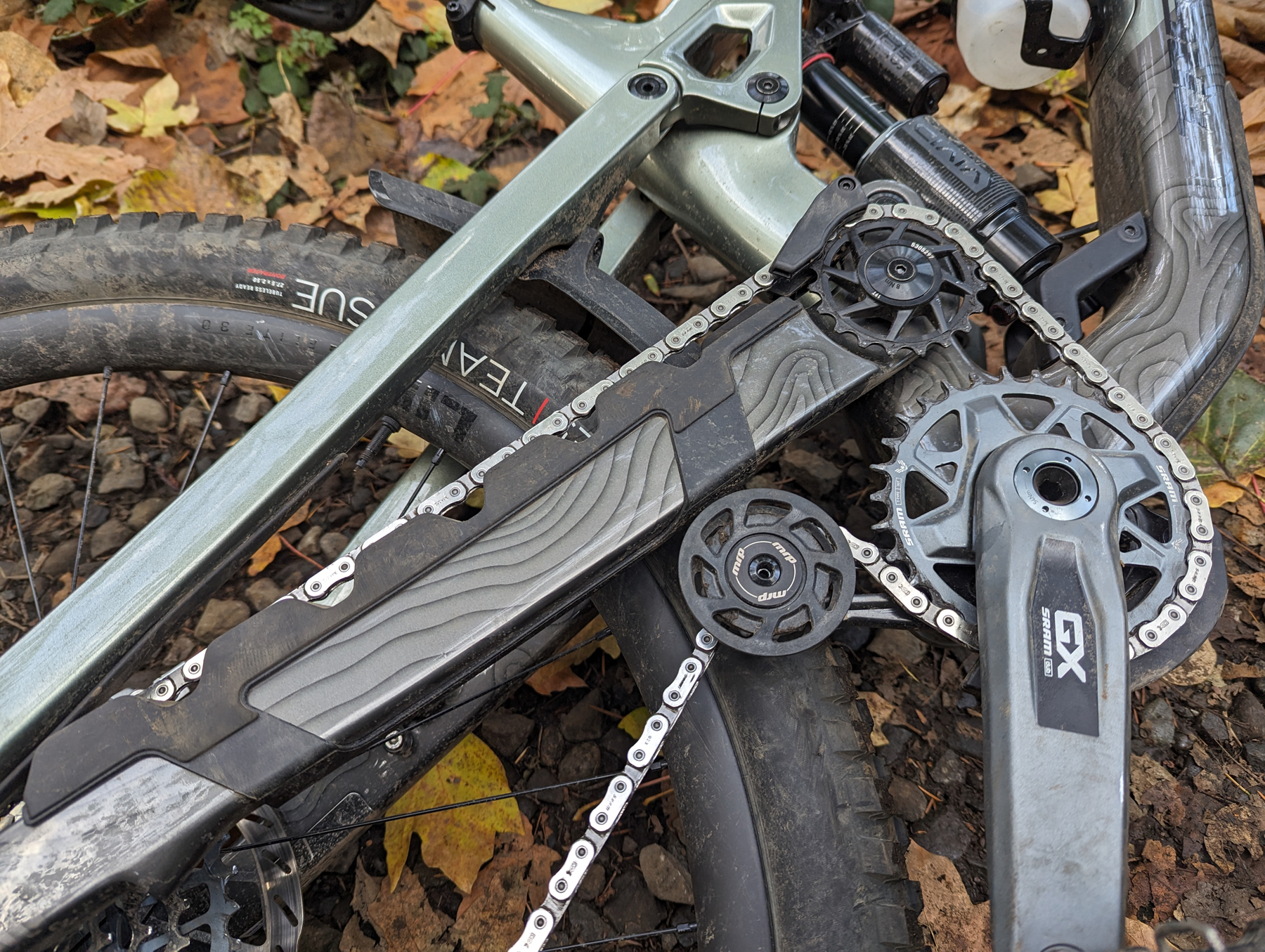
I followed up with Trek, and got word back that they’d been hasty in sending out the last set of recommendations — the 7 mm spacing was correct, but the pulley should be positioned lower than the MRP document called out, with 32 mm of spacing between the underside of the chainstay protector and the top of the pulley. And once I moved the guide back down to that setting, the chain stayed put — no more trouble again.
While that might seem counterintuitive, it makes some sense. Rotating the guide higher does increase the amount of chain wrap around the chainring (and therefore improves retention there) but also decreases the amount of chain growth along the lower run of the chain as the suspension cycles on the Slash — so that portion of the chain loses tension as the suspension compresses. Lowering the pulley a little bit increases tension on the lower portion of the chain as the suspension cycles, and for me, stopped the chain from coming off the chainguide pulley.
It’d certainly be nice if the chainguide setup wasn’t as sensitive, but there does seem to be a Goldilocks setting that works well. While I didn’t measure super precisely, the middle setting that I ran the guide in for the bulk of my testing was pretty close to the 32 mm spacing that Trek later recommended. Through that period, I had no issues with dropping the chain (even with the sub-optimal 6 mm spacing from the frame), nor did I have dropped chains after going to Trek’s stated 32 mm chainstay-to-roller gap and correcting the frame-to-guide spacing to 7 mm.
The build on our Slash 9.8 GX T-Type review bike is generally quite solid, though it’s not an especially great value for the money, at $8,000. The SRAM GX Transmission works well, and I’m a fan of the RockShox ZEB / Vivid suspension package; I didn’t miss the Buttercups (ZEB) or high-speed compression adjuster (Vivid) on the Select+ versions here too badly, as compared to their top-tier Ultimate counterparts. I was also glad to get the 200mm-drop Bontrager Line Elite dropper as compared to the 170mm-max RockShox Reverb AXS that comes on the 9.9 X0 build (I’m still very, very surprised that RockShox has yet to release a longer version). I didn’t get along with the shape of the Bontrager RSL one-piece bar / stem combo that comes on the higher-end 9.9 builds when I tested it on the Fuel EX earlier this year, and I also found the Bontrager Line Pro one that came on our Slash to be very, very stiff. I swapped it out for something more compliant and comfortable (a Spank Spike Vibrocore).
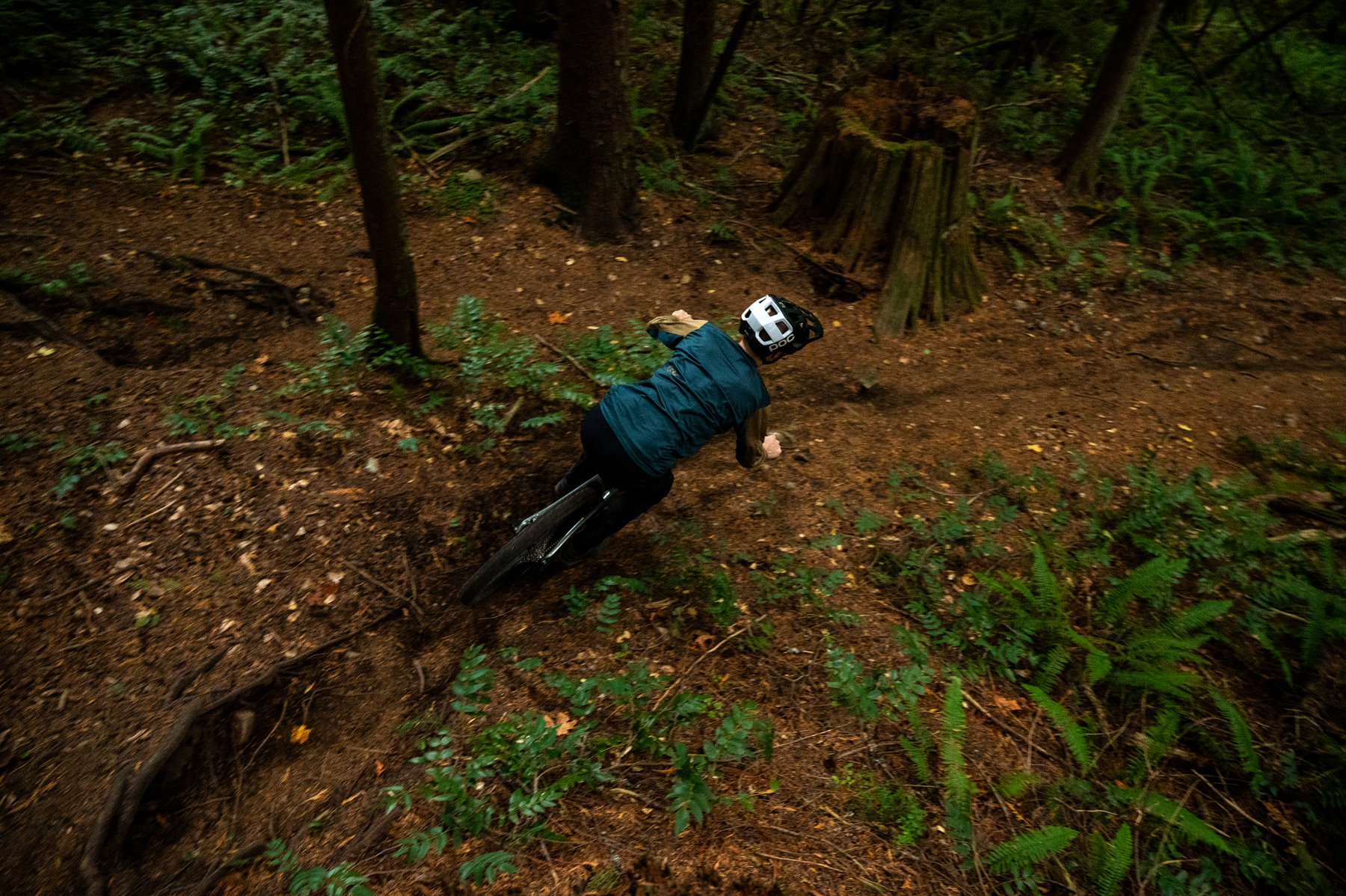
I also wasn’t a huge fan of the stock Bontrager SE6 front / SE5 rear tire combo — they work alright in drier conditions, but their relatively firm rubber doesn’t inspire much confidence on wet roots and rocks, and I also didn’t take long to put a couple of small holes in the casings. I swapped those out for beefier, grippier rubber (Continental Kryptotal DHs) for most of the test period, which felt better suited to the Slash’s capabilities.
While I was swapping wheels around, I also took the opportunity to put on a 220 mm front brake rotor. The SRAM Code Bronze Stealth brakes are a substantial improvement over the Code Rs that they effectively replace as the entry-level Code offering (I think mostly because they feature the Swinglink lever cam that the Code Rs lacked). But they’re still not the most powerful brakes out there, and the bigger front rotor helped on that front.
I would also love to see Trek offer the option for some full-29’’ builds on the Slash, at least in the larger sizes. Mullets are trendy and I absolutely get their appeal, especially for shorter folks on longer-travel bikes who could use some more tire-to-butt clearance. But as I described earlier, I personally clearly preferred the 29er setup on the Slash and it’d be nice to have the option without having to buy another wheel.
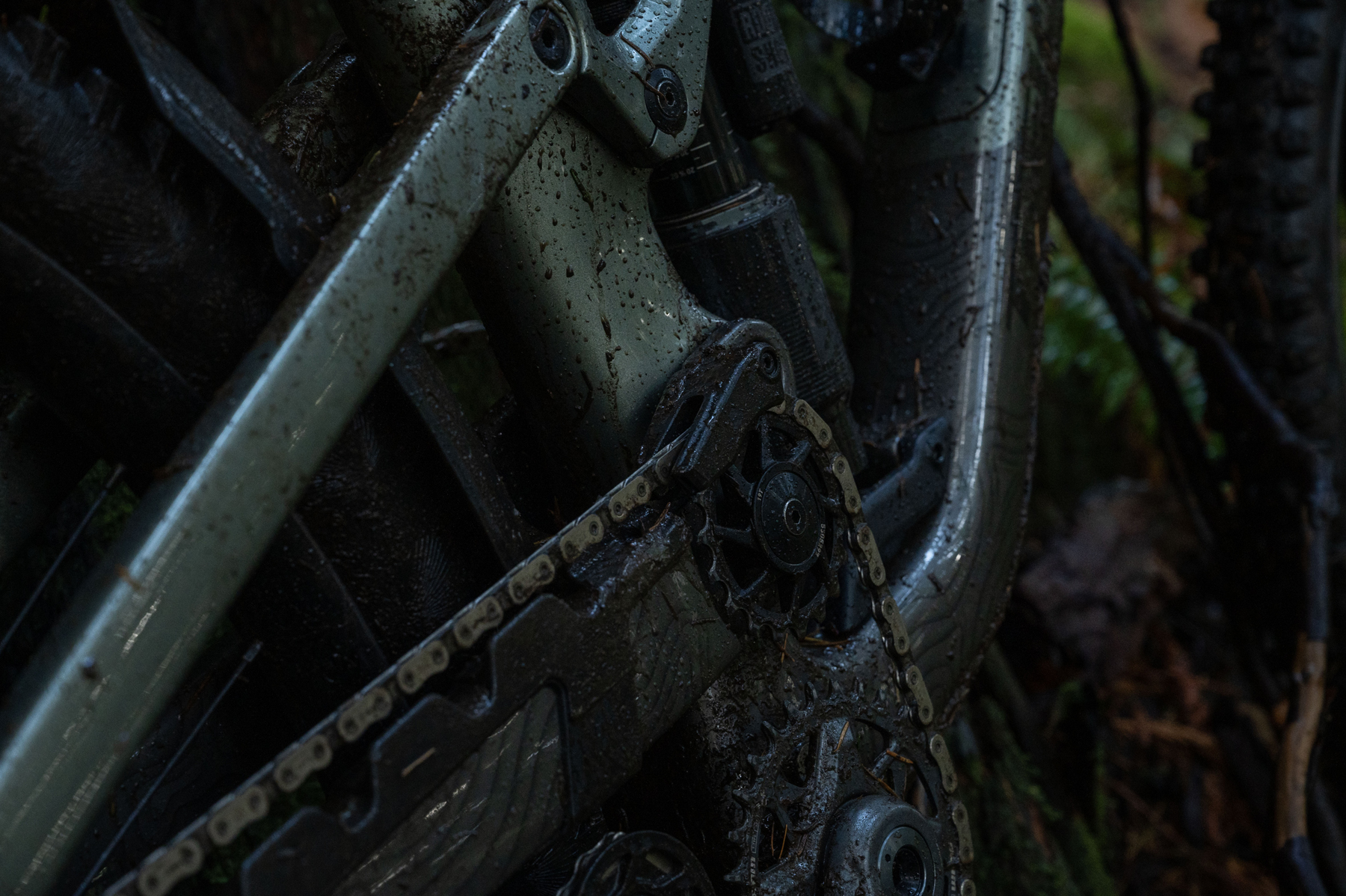
Who’s It For?
The Slash is a big, burly bike and is best suited to folks who are going to spend most of their time seeking out steep, technical descents — and try to ride them at pace. While it’s not the most engaging at lower speeds and on mellower trails, the Slash does pedal notably efficiently for what it is. It also does a very respectable job of not feeling completely out of its element if you’re taking things easier, and is generally very predictable and intuitive in its handling. The Slash would be a great Enduro race bike for folks whose preferences trend toward wanting a bike on the more stable, planted end of the spectrum, or those who just want a very confidence-inspiring bike for tackling big descents that still pedals to the top quite effectively, too.
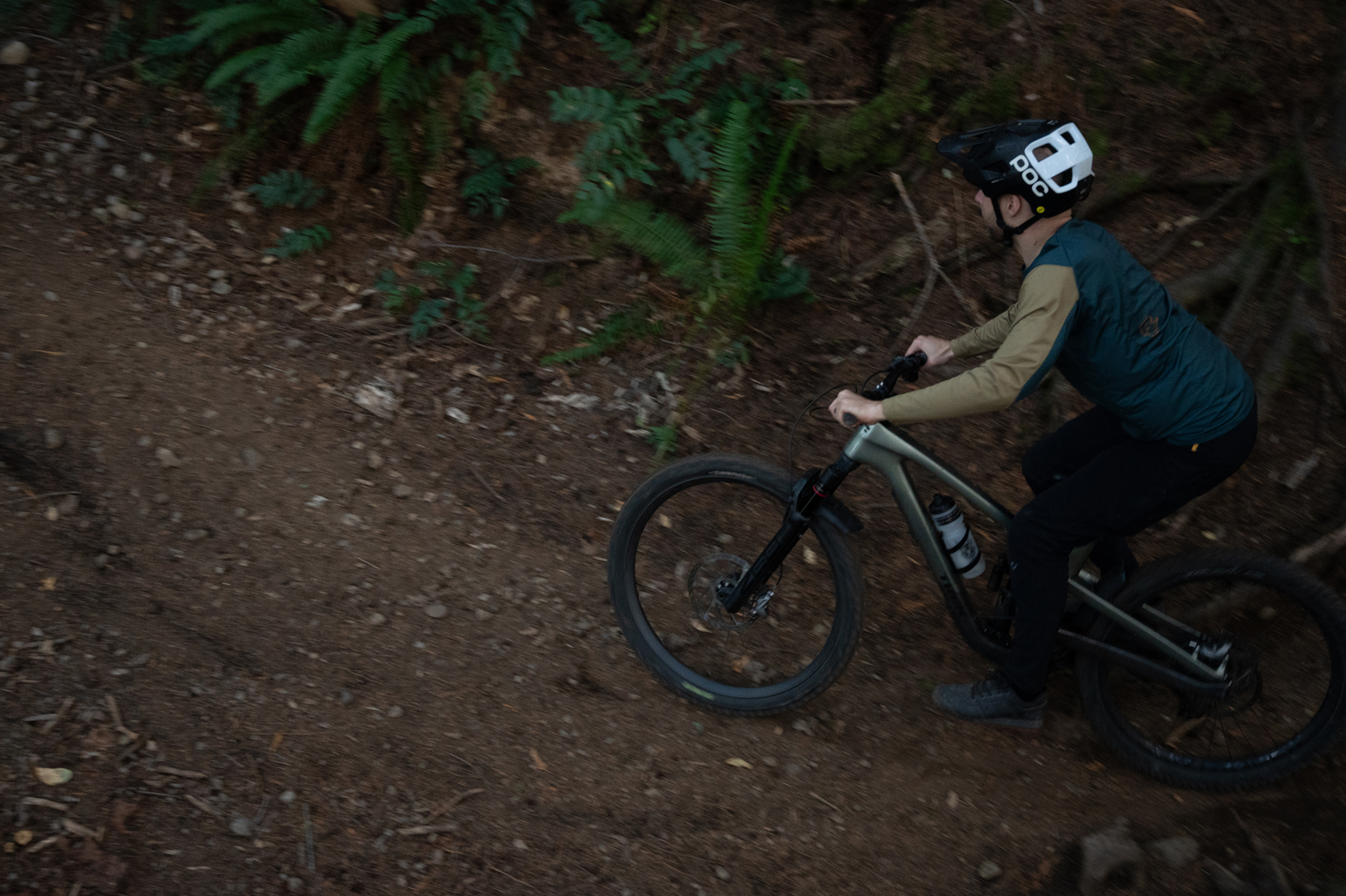
Bottom Line
The latest Trek Slash is undeniably a lot of bike — we’re talking about a 170mm-travel high-pivot platform, after all. It’s quite stable at speed, very composed and confidence-inspiring on steep, rough trails, and is less engaging on flatter, more mellow trails than most shorter-travel options out there.
But the Slash also pedals quite efficiently and does a surprisingly good job of feeling manageable in a relatively wide range of scenarios, beyond just wanting to charge on really burly descents. It would be nice to see a stock 29er option for the Slash, but as is it’s a great option for folks who want an especially stable, composed Enduro race bike, or a bike that’s particularly confidence-inspiring on very steep, rough descents while still pedaling relatively efficiently, and being a little more lively than most similarly planted and composed options, too.
Deep Dive Comparisons
BLISTER+ members and those who purchase our Digital Access Pass can check out our Deep Dive comparisons linked below. Get our Digital Access Pass to view all our Deep Dives and Flash Reviews, or become a BLISTER+ member today to get access to that and a LOT more, including the best worldwide Outdoor Injury Insurance, exclusive deals and discounts on skis, personalized gear recommendations from us, and much more.
Check out our Deep D ive comparisons of the Trek Slash to see how it compares to the Contra MC, Cannondale Jekyll, Norco Range, Forbidden Dreadnought, Canfield One.2 Super Enduro, Yeti SB160, Pivot Firebird, Santa Cruz Megatower, and Propain Tyee.
10 comments on “2024 Trek Slash”
Trek makes some great products and I’m sure they have done a ton of testing, but having owned an idler bike (cannondale jekyll), I will never own a 2 idler bike.
Nice and thorough review. I was looking forward to your comparison to the Nomad v6, any quick thoughts?
Pretty different. The Slash actually pedals a little more efficiently but is more stable at speed and less nimble / easy to throw around. And especially with the Slash in the stock mullet configuration they prefer quite different body positioning, with the Nomad favoring a much more centered, upright stance.
At a quick glance the most strikingly similar design to the Slash seems to be the Kavenz VHP 16 which was an interesting bike reviewed earlier this year. As someone interested in the Kavenz because of your exposure I’d love to know how they compare. Otherwise, another great review!
Good call, though they don’t remind me of each other that much.
The Kavenz is more lively, nimble, and generally playful feeling; the Slash is more stable, planted, and feels more focused on going fast / outright composure at speed. The Slash feels fairly manageable in tight spots and on mellower trails for what it is, but the Kavenz is quite a bit more versatile overall.
What if you could try the Kavenz with the newer longer chainstays? Seems like a lot of straight line stability and nimbleness comes from the chainstays.
I’d want to try it before I say anything definitive, but the Kavenz with the new adjustable length chainstays (and tweaked sizing — I’d probably go up to an XL on it now, especially with longer chainstays) seems really intriguing.
Exhaustive. Can you pls compare the Slash to HD6?
We’ve been trying to get on an HD6 but haven’t been able to make it happen yet, unfortunately.
Curious to know what your suspension settings were?
Leave a Comment Cancel reply
- Pinkbike.com
- Register New User
- First Looks
- Friday Fails
- Community Blogs
- Fantasy League DH
- Places Directory
Field Test: 2021 Trek Slash - Ready to Race
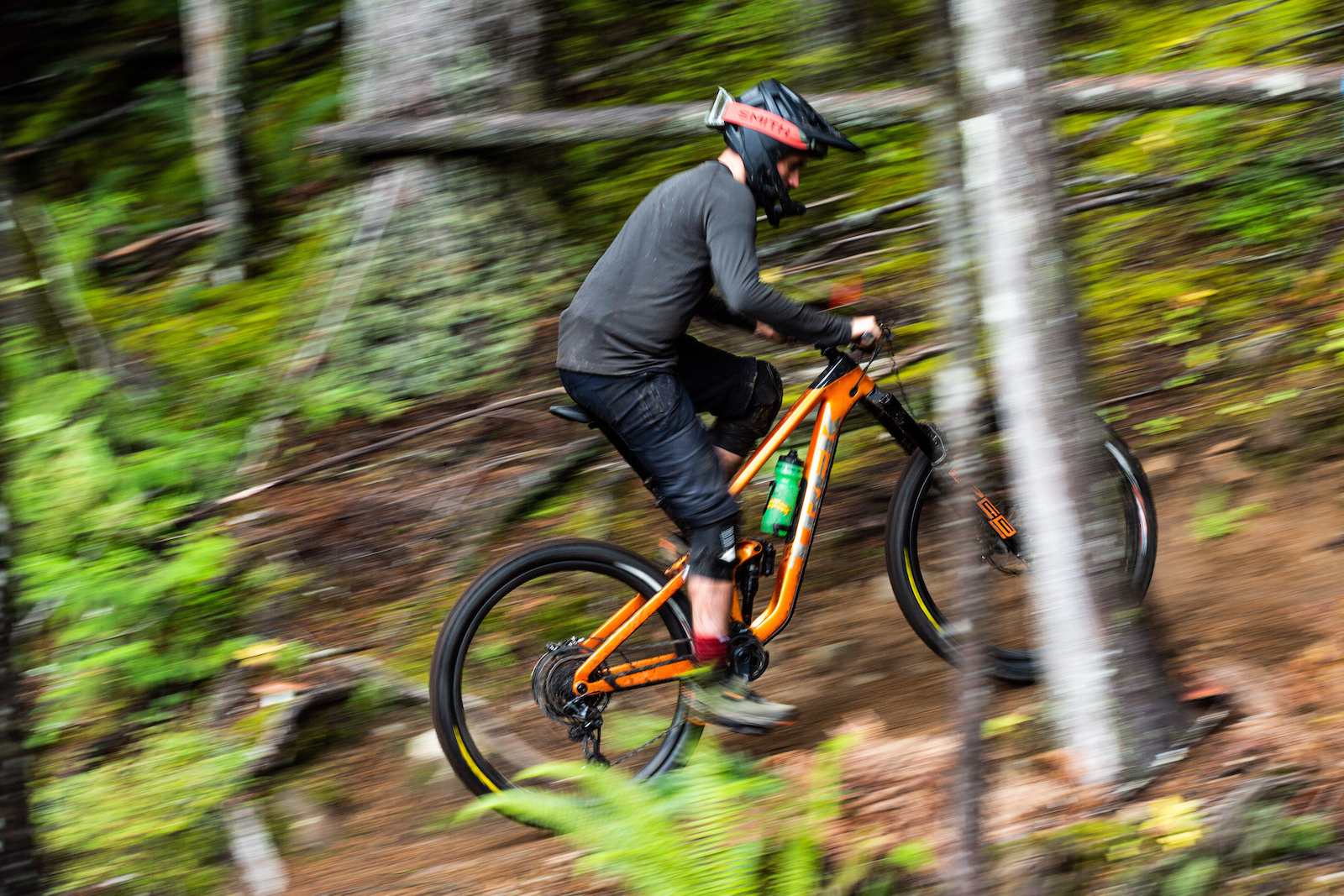
Cool Features

- Find Us Store
- My Account My Account
- Subtotal : $ 0.00 Checkout Cart
- BIKE ACCESSORIES
- 2021 Slash Alloy Chainstay Armor
Trek 2021 Slash Alloy Chainstay Armor
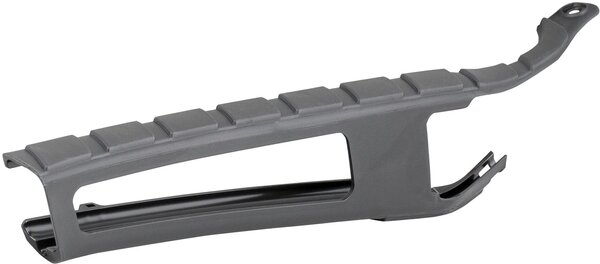
Keep your investment protected with durable armor designed specifically for your ride. - Protection engineered to keep your ride looking as good as new for years to come. - Trek protective armor - Model-specific custom fit
Part Numbers
VIDEO: N1NO BEYOND EPISODE 1 – NEVER QUIT
THE DVO BRAND STORY – HOW A PASSION FOR RIDING INSPIRED A SUSPENSION COMPANY
VIDEO: KRISS KYLE VS DANNY MACASKILL GAME OF BIKE
VIDEO: SEASON 2 OF RED BULL TV’S “BEYOND THE LINE”
- THE REPORT FROM THE WORLD CUP DOWNHILL RACES IN POLAND
- WORLD CUP DOWNHILL RESULTS FROM POLAND
YETI TURQ WIND VEST REVIEW – THE IDEAL SPRING COMPANION
- MARIN LAUNCHES ALL-NEW ALPINE TRAIL E BOSCH MODELS
- KONA’S FOUNDERS BUY BRAND BACK FROM KENT OUTDOORS
- MOUNTAIN BIKING’S TWO-TIME MEN’S OLYMPIC GOLD MEDALIST, JULIEN ABSALON

TREK SLASH GEN 6 REVIEW – A GENERATIONALLY DEFINED TWO-WHEELED ENDURO MARVEL
This high pivot enduro bike is one of the best we've tested.

TREK SLASH GEN 6 REVIEW
There has been a Slash in Trek’s arsenal for just over 10 years, and it has undergone five generations of upgrades coming into the end of the 2023 season. This time, however, Trek didn’t just upgrade the Gen 6 Slash, they completely reimagined it. It goes without saying that the new Slash is longer and slacker than the previous generation, but Trek had a few other things up its sleeve, which was hinted at in their bike releases the last few years. We saw the high pivot come into form on the Session in the 2022 model year, and earlier this year the release of the Fuel EX showcased Trek’s interest in engineering diversely adjustable bikes, both of which carry into the sharply engineered Gen 6 Slash.
Trek’s signature OCLV Mountain Carbon is employed in the construction of this frame, making up both the front and the rear triangles. Dual-density downtube protectors guard against rocks and tailgate damage, and an extensively engineered chainstay protector helps keep the bike quiet when things get rough. Under the clear coat of paint on the downtube, they’ve added an impact-resistant film that acts as frame protection against light damage. They upgraded their storage box with a wider mouth opening and contained the cables and hoses in their own tubes to eliminate snag points when taking out the storage bags inside the frame.
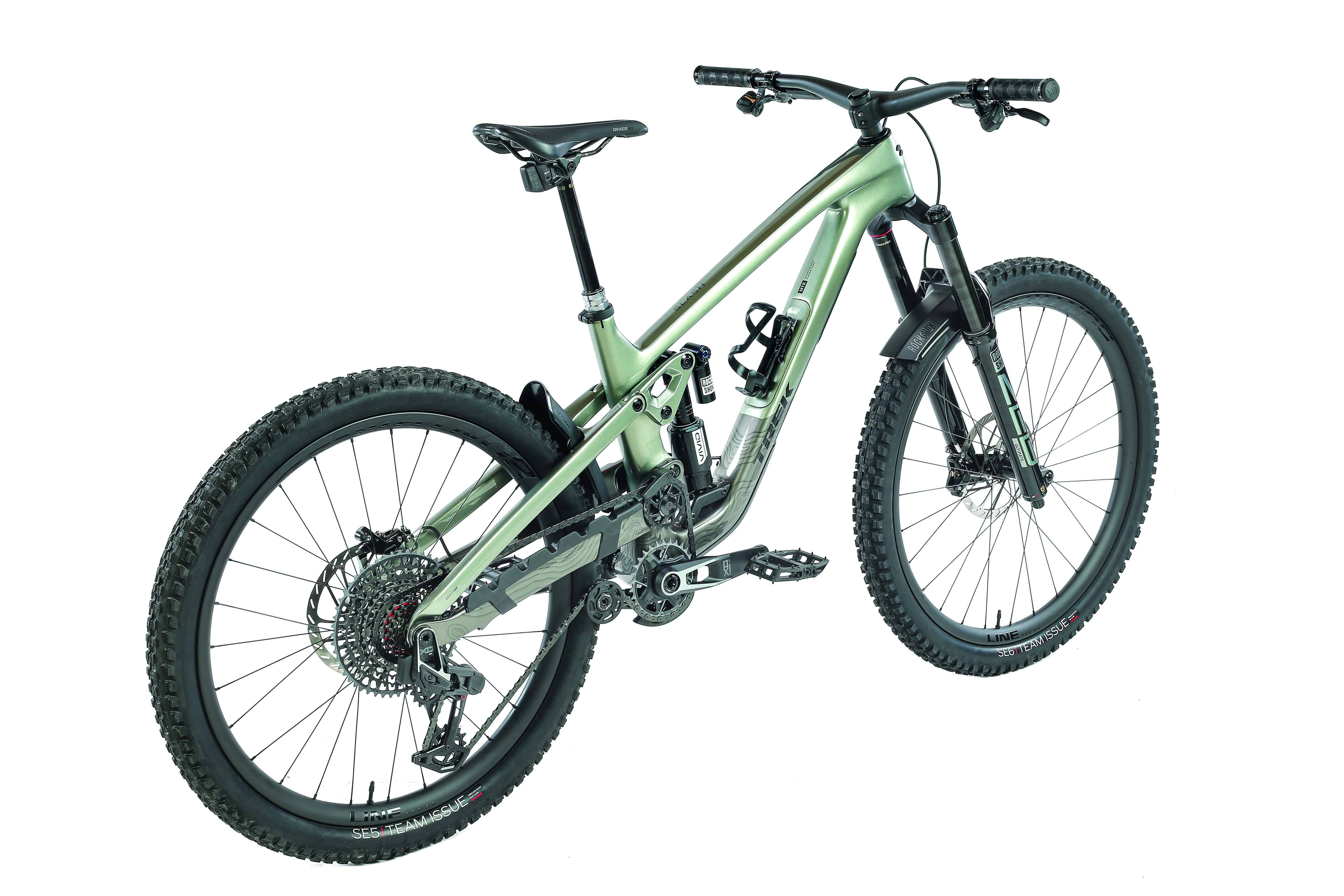
The bike is only sold with a mixed-wheel setup, but the bolt-on shock mount can be swapped to allow a 29-inch back wheel to be used without changing the bike’s geometry—this goes for all sizes except size small, which is only available with 27.5-inch wheels. It comes from the factory with a neutral headset cup, which gives the bike a head angle of 63.3 degrees and an effective seat tube angle of around 77 degrees depending on which size you get. You can get an angle-adjust headset cup that will steepen or slacken the bike by 0.7 degrees. Our M/L-size test bike has a 434.2mm chainstay length, but Trek gives this bike size-specific chainstays to keep a consistent ride feel throughout the size range.

Trek has jumped on the bandwagon of high-pivot bikes with the allure of the rearward axle path that they claim allows the bike to carry speed more effectively throughout the trail, specifically on square-edged rocks. They’ve combined this 170mm-travel high-pivot system with their existing ABP (Active Braking Pivot), which they say allows them to separate the anti-squat and anti-rise characteristics and tune them individually. This system is designed to keep the suspension active even under heavy braking, keeping traction to the rear wheel at a premium.
According to Trek, they’ve been able to keep the anti-squat number at just over 100 percent throughout the stroke. This basically means the suspension won’t be affected by your pedaling movement no matter where you are in the bike’s travel.
This Slash has a couple of other tricks up its handlebars with a rear suspension flip chip to adjust the progression located in the bolt-on shock mount at the base of the shock. This is the same bolt-on mount that can be swapped out to accommodate a 29-inch rear wheel. Our test bike came spec’ed with RockShox’s new Vivid Ultimate high-volume air shock with an adjustable hydraulic bottom-out, a climb switch, and high- and low-speed compression adjustments.
This is matched to a 170mm-travel RockShox Zeb Ultimate fork with the Charger 3 RC2 damper with high- and low-speed compression adjustments. They’re saying this bike is compatible with up to a 190mm fork with a 606mm axle-to-crown measurement if you decide to make it more of a park bike.

The Slash 9.9 XO AXS T-Type build, which we tested, featured the excellent SRAM XO AXS Transmission, Code Silver RSC brakes and a 170mm-travel RockShox Reverb AXS dropper post. This bike has a unique chain line consisting of an oversized 19-tooth upper idler pulley, an MRP bash guard and lower idler pulley, and a 30-tooth chainring attached to 165mm XO cranks. I
t also contained some Bontrager components in the mix with the RSL integrated handlebar/stem system, grips and saddle, along with Line Pro 30 carbon wheels wrapped in a Bontrager SE6 Team Issue front tire and a SE5 Team Issue rear tire. This wheel and tire combination we felt was a weak point of the bike because we broke a spoke nipple on the third ride out and just couldn’t get comfortable with the grip the tires offered.
Trek offers several build options for the Gen 6 Slash, including the aluminum Slash 8 that starts at $4,400 and includes every feature the Carbon 9 models have. From there, they go up in price and build spec with every size—from S, which is 27.5 inches only, to M, M/L, L and XL, all of which are mixed-wheel builds topping out at $11,500 for the Slash 9.9 XX AXS T-Type build.

For a high-pivot bike, the Gen 6 Slash is an excellent climber. We were impressed with the ease of forward momentum when the trail pointed uphill. We did some experimentation with the progression chip at the base of the shock and found that, though the climbing performance was enhanced, it wasn’t enough for us to want to flip it every time we rode mellower trails, as the bike performs perfectly well in the less progressive setting. Steep technical sections were a pleasure to climb, and generally boring road climbs and traverses seemed to pass more quickly than normal aboard the Slash. Though we flipped it once just to see if it helped, we never felt the need to use the shock’s climbing switch.
We were impressed with the bike’s composure on any ascent. We also liked how the shorter 165mm cranks worked with the 27.5-inch back wheel, giving us both ground clearance in sticky situations and the quick acceleration we associate with mullet bikes. We never had a pedal strike while riding this bike, which made pedaling along narrow shelves and up technical bits a more peaceful experience.

Aside from experiencing some technical malfunctions, none of which have anything to do with the frame, we were more than happy with the descending performance of the Gen 6 Slash. Our initial impression of high stability continued on through the duration of the test as we pushed limits and enjoyed each second of riding this bike.
For the first few days on the bike, we felt a strange flex in the back of the bike that we thought might have been associated with frame flex due to experiencing an intense squeaking when rounding sharp corners at speed. We figured out later this was an unfortunate combination of the flimsy-feeling Line Pro 30 rear wheel flexing and a sticky piston in the brake caliper rubbing the rotor in an annoying fashion.
As soon as we troubleshot these issues, we were able to experience the full descending potential of the Gen 6 Slash. It’s one of those “The faster you go, the better it feels” types of bikes that encourages less brake usage. When you are eventually forced to use the brakes, the suspension responds as if you’re not and remains as active and supportive as ever.
We found ourselves late braking into all kinds of corners and whipping around them faster than we’d normally have done, ready to face the next one. We also felt the bike’s composure on the steeps and in intense rock gardens, which it skipped or floated through rather than getting hung up in the crevasses. When we experimented with the progression switch, we found the added support to be a little too much on all but the most mellow sections of the trail and quickly flipped it back, as we were more than happy with the performance in the less progressive setting.

WHAT DID WE LOVE?
There was a lot to love about this bike that we feel needs a shout-out. Most of our testers loved the 165mm XO cranks and wished more companies would add 165mm cranks to their bike’s specs list. RockShox’s new Vivid Ultimate shock was excellent throughout testing, taking very little time to set up and even less time to adjust for added comfort and traction. We were also impressed with the bike’s overall stability and maneuverability wherever we were on the mountain, bringing the confidence of a big bike and the joy of a smaller bike.
WHAT DID WE HATE?
This might be a bit longer than normal, and that’s mostly due to the Bontrager products supplied with this bike. Aside from the grips and the saddle, we didn’t particularly like any of them, especially the tires and rear wheel. While they performed adequately enough to have fun on the trail, we never quite felt the confidence in grip that we feel when a Maxxis Minion or American Classic Vulcanite is mounted to the wheels.
The rear wheel was a whole problem in itself, because while the hub action was good, the wheel as a whole flexed far too much for comfort, and we even broke a nipple at the bike park on just the third day riding the bike. The RSL integrated bar and stem didn’t have the adjustability we’d prefer, and most would have liked to roll the bar angle back just a little bit if they could. The BITS headset tool proved to be useful, but very hard to get out of the head tube when needed, which was annoying.
Our other complaints were about the fork and rear brake, both of which could happen to any build. The rear brake suffered from a stuck piston and was very far over to one side, meaning the rotor rubbed on the caliper itself. This was an easy fix. The fork formed a weird clunk in the rebound stroke, which made it hard to ride at any speed, so we had to get a warranty replacement to complete the test. All of these things gave us a bit of a love/hate relationship with the bike more severe than with most bikes. Were we to own this bike ourselves, these would have been warranty issues or we’d simply swap out all the troublesome parts and enjoy the excellent performance this frame can offer.
BOTTOM LINE
Our feelings about the Gen 6 Slash may be mixed, but the good outweighs the bad, and we were able to get past the inconveniences. This bike is very versatile in the gravity side of things, so if you’re looking for an enduro race bike, backcountry exploration rig or park sender, the Slash has you covered. A quick swap over to your preferred parts and this bike will serve its rider well for a long time. Because of the component’s spotty performance, our recommendations are damped on this particular build, but we feel it’s still well worth consideration when looking for your next full-send rig.
TREK SLASH 9.9 XO AXS T-TYPE
www.trekbikes.com
CATEGORY: Enduro
SUSPENSION: 170mm (front/rear)
TIRE SIZE: 29″/27.5″ mixed
Price: $9,400 Weight: 34.7 pounds (without pedals) Sizes: S, M, M/L (tested), L, XL Frame tested: 170mm, OCLV Mountain Carbon (travel and material) Shock: RockShox Vivid Ultimate Fork: RockShox Zeb Ultimate Wheelset: Bontrager Line Pro 30 carbon Tires: Bontrager SE6 Team Issue (29×2.5″) front, SE5 Team Issue (27.5×2.5″) rear
Seatpost: RockShox Reverb AXS (170mm travel) Saddle: Bontrager Arvada Handlebar: Bontrager RSL integrated handlebar/stem Stem: Bontrager RSL integrated handlebar/stem Grips: Bontrager XR Trail Pro Headset: Integrated cartridge bearing Brakes: SRAM Code Silver Rotors: SRAM 6-bolt 200mm (f), 200mm (r) Rear derailleur: SRAM XO AXS Eagle, T-Type Shifters: SRAM AXS POD Ultimate Crankset: SRAM XO Eagle, 165mm Bottom bracket: SRAM DUB, 73mm, BSA threaded Cassette: SRAM Eagle XS-1295, T-Type, 12 speed, 10-52T Chain: SRAM XO Eagle, T-Type, 12-speed Chainrings: SRAM XO T-Type, 30-tooth
GEOMETRY SIZE M/L
Head tube angle: 63.3° Effective seat tube angle: 77.3° Reach: 468.1mm (18.4″) Stack: 632.1mm (24.9″) Bottom bracket height: 351.1mm (13.8″) Chainstay length: 434.2mm (17.1″) Wheelbase: 1253.2mm (49.3″)
U23 XCO RESULTS FROM THE PAN AMERICAN GAMES
VIDEO: CHASING TRAIL EPISODE 38 – IN SEEK OF SQUAMISH, BC’S UNRIDDEN MOUNT HABRICH TRAILS
SNOW SUMMIT, SNOW VALLEY, AND MAMMOTH MOUNTAIN ANNOUNCE BIKE PARK OPENING DAYS

mountainbikeaction
- Since 1986 - Covering All Aspects of ⛰🚲 #MBAmagazine

- Bike Builds
- Cross Country Bikes
- Downhill Bikes
- Enduro Bikes
- Hardtail Bikes
- Trail Bikes
FASTHOUSE TRACKER PACKABLE WINDBREAKER REVIEW
ABUS CLIFFHANGER MIPS HELMET REVIEW
EVIL LOOPHOLE WHEEL REVIEW – A CRACKING GOOD SET OF CARBON WHEELS
VIDEO: CHASING TRAIL EPISODE 38 – IN SEEK OF SQUAMISH, BC’S UNRIDDEN…
ASK MBA: HOW DO I REPLACE A BROKEN SPOKE?
ASK MBA: WHAT’S THE BEST WAY TO FLY WITH MY BIKE?
ASK MBA: WHY DO MY BIKE’S DISC BRAKE PADS KEEP RUBBING?
ASK MBA: WHY AM I HAVING TROUBLE ALIGNING SHIMANO MICROSPLINE COGS?
THE INS AND OUTS OF FRAME PROTECTION – THE BEST WAYS TO KEEP YOUR FRAME LOOKING…
HOW TO SERVICE A PRESS-FIT BOTTOM BRACKET
ASK MBA: SHOULD YOU REPLACE THE ROTOR ALONG WITH YOUR BRAKE PADS?
ASK MBA: HOW DO I DIAL IN MY FOX 34 FORK?
BIKE CHECK: BRYN ATKINSON’S PIVOT SHUTTLE LT E-BIKE
MATHIEU VAN DER POEL TELLS US ABOUT HIMSELF AND HIS MOUNTAIN BIKE, MBA SEPTEMBER 202O
BIKE CHECK: LARS FORSTER’S THÖMUS LIGHTRIDER WORLDCUP
The Greatest Riders in Mountain Bike History (Updated)
- Mountain Bike Action
- Digital Mountain Bike Action
- Back Issues
- NICA Team of the Month
- B’s Buzz
DESTINATION: WHISKEY RUN OREGON – A NOT SO SECRET RIDING PARADISE
DESTINATION: SPIDER MOUNTAIN TEXAS – COME FOR THE BBQ, STAY FOR THE RIDING!
DESTINATION SLOVENIA – RIDING BENEATH THE EARTH
VIDEO: TRANSITION FACTORY RACING EP. 1 – FT. WILLIAM
PHOTO GALLERY: THE BEST OF SEA OTTER CLASSIC 2024
CAPE EPIC STAGE 4 RESULTS AND FULL STAGE VIDEO
CAPE EPIC STAGE 3 RESULTS AND FULL STAGE VIDEO
READER SENDS: THIS MONTH’S BEST READER-SUBMITTED PHOTOS
READER SENDS – THIS MONTH’S BEST READER SUBMITTED PHOTOS
READER SENDS – THIS MONTH’S BEST READER SUBMITTED PHOTOS
- Anneke’s Blog
- Down The Trail
2024 Trek Slash Review | Is this high pivot enduro bike fashionably late, or just late to the party?
The not-so-minor details, 2024 trek slash 9.8 gx axs.
https://www.trekbikes.com
From $6,999 AUD ($10,499 AUD as tested)
- Incredible composure on the rowdiest terrain - Plush & well-controlled suspension - Surprisingly efficient pedalling performance - Mullet setup injects welcome agility - Loads of in-built adjustability
- Extra pulleys add complexity & noise - Tyres too flimsy for the application - Downtube storage is on the small side - Chainstay armour lacks damping - GX derailleur clutch failure
Dan reviews the 2024 Trek Slash
The Trek Slash has undoubtedly been one of the most popular enduro bikes on the market since it was first introduced back in 2011. It was late 2020 when we tested the last version, which impressed us with its buttery-smooth suspension performance and surprising agility for what was a big and burly brawler.
For 2024 however, the Slash has been completely redesigned from the ground-up. Featuring a high pivot suspension design, additional pulley wheels and a mullet setup, it is quite clearly a very different bike to its predecessor.
So how do all the changes play out on the trail? And what about those online reports of chain-dropping issues? We’ll be discussing all of that, and more, in our in-depth review of the new 2024 Trek Slash.
Watch our video review of the 2024 Trek Slash:

It eats up square edge hits for breakfast, while the neutral anti-squat and ABP platform means the back end is unencumbered by drivetrain and braking forces.

An overview of the 2024 Trek Slash
Built for enduro racing and bikepark thrashing, the Trek Slash is designed to compete with the likes of the Merida One-Sixty , Giant Reign and Canyon Strive .
Featuring an all-new frame for 2024, the Slash is now equipped with 170mm of travel front and rear. It comes set up from the factory as a mullet, though by fitting a different shock mount it’s possible to run a 29in rear wheel. The exception is the Small frame size that is purpose-built around 27.5in wheels front and rear.

You’ll still find a four-bar ABP platform, with the most rearward pivot located around the rear axle to help isolate brake forces from the suspension. Trek’s engineers have moved the main pivot almost halfway up the seat tube, which creates a more pronounced rearward axle path. To mitigate chain growth, a large 19T idler wheel routes the chain close to the main pivot. Trek claims this produces around 100% anti-squat all the way through the travel, with the goal being to reduce pedal-bob.
There’s a gazillion other features incorporated into the new Slash, including downtube storage with a second generation hatch design, bolt-on mudguards and frame armour, as well as a flip chip in the lower shock mount that offers linear or progressive suspension settings. While almost every Slash comes equipped with the new RockShox Vivid air shock, the frame is also compatible with coil shocks.

Trek Slash geometry & sizing
Just like the latest Fuel EX , the new Trek Slash incorporates modular headset cups. Complete bikes come from the factory set up in the neutral position with a 63.5° head angle, though by removing the upper headset cup and installing an asymmetric cup you can slacken that out to 62.5° or steepen it to 64.5°. You will have to purchase the asymmetric cup separately for $64 AUD however.
There are some further changes in geometry over the old bike. The seat angle is considerably steeper at around 77-78°, and Trek has also updated the Slash with size-specific rear centre lengths. This is achieved by modifying the location of the BB on the main frame, which varies the rear centre from 429mm on the Small, to 445mm on the XL.
Listed below is the geometry chart below for all five frame sizes. This shows the geometry when matching wheels are fitted (27.5in wheels on the Small, 29in wheels on the M-XL sizes). In the mullet configuration, the angles slacken by 0.2°, the BB drops by 2mm and the rear centre length shortens by nearly 6mm.

Trek Slash price & specs
There are six models in the Trek Slash lineup for 2024. Prices start at $6,999 AUD for the Slash 8, which is the only alloy model in the range. At the other end of the spectrum is the Slash 9.9 XX AXS that sells for a staggering $19,999 AUD. That’s a truly insane amount of money for a bike that doesn’t come with a mid-drive motor.
Thankfully the bike that we’ve been testing is quite a bit more reasonable. It’s the Trek Slash 9.8 GX AXS, which sells for $10,499 AUD. Despite being the second cheapest model it still features a full carbon frame, high performance RockShox suspension and a wireless SRAM GX AXS Transmission, making it an appealing package.

- Frame | OCLV Mountain Carbon, ABP Suspension Design, 170mm Travel
- Fork | RockShox Zeb Select+, Charger 3 RC2 Damper, 44mm Offset, 170mm Travel
- Shock | RockShox Vivid Select+, 230x65mm
- Wheels | Bontrager Line Elite 30, OCLV Carbon Rims, 29mm Inner Width
- Tyres | Bontrager SE6 Team Issue 2.5in Front & SE5 Team Issue 2.5in Rear
- Drivetrain | SRAM GX Eagle AXS Transmission 1×12 w/34T Alloy Crankset & 10-52T Cassette
- Brakes | SRAM Code Bronze w/200mm Centerline Rotors
- Bar | Bontrager Line Pro, OCLV Carbon, 27.5mm Rise, 820mm Width
- Stem | Bontrager Line Pro, 35mm Length
- Grips | Bontrager XR Trail Lock-On
- Seatpost | Bontrager Line Elite, 34.9mm Diameter
- Saddle | Bontrager Arvada, Austentite Rails
- RRP | $10,499 AUD

With the Slash however, the smaller rear wheel seems to help counter some that ground-hugging sensation.

Trek Slash weight
Confirmed weight for our Trek Slash test bike is 16kg, without pedals and with the tyres set up tubeless. That’s notably higher than the claimed weight of 15.65kg, and it’s also quite a bit heavier than the previous Slash we tested, which came in at 14.56kg.
Still, it’s in the ballpark for a 170mm travel enduro bike these days, especially one that’s built around a high pivot design.
It’s all pretty burly too, including the Bontrager Line Elite carbon wheelset that weighs a bit over 2kg. These wheels are a great match for the Slash, being quite stiff and also hella durable.
We can’t say the same for the Bontrager tyres however, which at around a kilo each are too lightweight for a proper enduro bike. Unless you want to swap the tyres straight away, we’d recommend at least fitting an insert into the rear wheel to lessen the chance of puncture pain.

Testing the 2024 Trek Slash
We put the Trek Slash into the hands of our enduro tester Dan, who’s aggressive riding styles regularly leaves corners and berms shaking in their boots. Having spent a load of time on the previous version, Dan was perfectly placed to see how this new Slash would compare.
Before putting tyres to dirt however, we had some concerns around the chain-dropping issue that had been reported by reviewers and users online. We spoke with our local Trek dealer, which informed us about a service bulletin that had been issued to address this problem. It turns out that bikes from earlier production runs were being assembled with incorrect spacing for the chainguide, as well as too big of a gap between the chainstay and the lower pulley wheel.
Although our test bike had previously been ridden by another media publication, upon closer inspection we discovered that neither the chainguide spacing or lower pulley wheel were set up correctly. After sourcing the right spacers, a few adjustments with a hex key was all that was required to get everything lined up to spec.

Since making those adjustments we have not once dropped the chain during six weeks of abusive testing. Even still, Trek has informed us that it has developed a replacement upper idler that features taller teeth for more positive engagement with the chain. The replacement idler should be available in early 2024 and will be sent out to Trek dealers to be installed on existing bikes, free of charge.
As such, most customers shouldn’t encounter any chain dropping problems if the bike has been set up properly from the shop. If you are having troubles with your Slash, be sure to check out the service bulletin .
How have you found the fit of the bike Dan?
I’m 183cm tall and the size Large feels spot on. The 488mm reach is almost identical to the previous Slash, but you’re not nearly as stretched out since the seat tube is quite a bit steeper. I still needed to slide the saddle forwards a bit to get a comfortable seated climbing position, but not nearly as much as the old bike.
With that saddle adjustment the Slash fits perfectly. The climbing position is very comfortable, and on the descents you’re nicely centred, giving you a feeling of being ‘in the bike’.

What about the contact points?
The Trek Slash comes standard with 820mm wide bars, which I chopped down to a more sensible 780mm. The Bontrager carbon bars have always looked a bit funny to me, but once I rolled them so that the grips were flat they were fine. They are quite stiff, so you’re likely to notice some feedback at cruising speeds. That said, we’re glad to see a conventional two-piece setup rather than the one-piece carbon cockpit that comes on the higher-end Slash models. Adjustments are easier and it’s obviously a lot cheaper if you want to change out either the stem or bars to suit your preference.
I also swapped the grips straight away, as I can’t get on with the flared alloy lock-rings on the outboard side of the Bontrager grips. I feel like they really dig into the outside of my palms, since I ride with my hands on the very edge of the bars.

Talk us through your suspension setup
Setting up the suspension on the Slash is made relatively easy thanks to Trek’s online calculator . This gives you a great starting point for pressures and rebound settings, all of which are based off your weight. Furthermore, the RockShox Vivid shock has gradients anodised onto its stanchion to help you eyeball sag.
For my 83kg riding weight I needed 209psi to hit the recommended 30% sag for the rear shock. I found Trek’s suggested rebound setting (12/20 clicks) to be too fast for my preference and ended up slowing it down to just five clicks out. I backed the compression adjuster off to its most open position (-2) and ran the Hydraulic Bottom Out dial in the middle of its range.
I set up the Zeb fork as recommended by both Trek and RockShox with 63psi in the DebonAir+ spring. Again I ran a slower rebound setting than suggested, ending up on a 7/18 clicks. I backed off the high-speed compression dial all the way (-2) and added a few clicks from neutral for the low-speed adjuster (+4).

What do you dig about the Trek Slash?
The Trek Slash is an insanely good descending bike. It’s got a great stance on the trail, as you’d expect given the geometry is so close to a full-blown DH bike. However, it’s the top-notch suspension performance that makes it such a beast when gravity takes over.
The RockShox Vivid is very impressive, offering a level of sensitivity that isn’t that far off a coil shock. It’s supple over smaller bumps and chatter, and rear wheel traction is excellent as a result. There’s also great support, and the HBO adjuster allows you to dial in more end-stroke damping if you’re a particularly hard lander.
Trek’s high pivot suspension design has to be commended too. It eats up square edge hits for breakfast, while the neutral anti-squat and ABP platform means the back end is unencumbered by drivetrain and braking forces. This helps the Slash to flow smoothly through chunky rock gardens and high-speed braking bumps, isolating you from the chop while keeping the tyres driving into the ground.

What’s particularly impressive is how the Slash manages to be so plush while maintaining control at higher speeds. It thrives on bombing down steep and technical terrain and it only gets better the harder and faster you push it. With that in mind, I suspect few riders will be likely to find its limits.
Still, I was surprised at how rideable it was outside of full-gas descending. While the suspension is supple, it rides high in its travel and there’s plenty of support for handling bigger hits. This makes the Slash stable and predictable to jump with, and providing you’ve got the inclination, it can be quite playful too.
What does the mullet setup bring to the party?
I think this is a big reason why the Slash doesn’t feel like a total anchor on flowier trails.
In general I like the mullet setup, as it makes the bike more manageable for steep descending. It’s also great through tighter corners, as you’re able to flop the bike over and change direction a bit easier. In these situations a full 29er can stand you up a bit sometimes, especially if you’re on the brakes. Add a high pivot suspension design into the equation and the bike gets harder to manoeuvre due to the way the rear end gets longer as the shock goes into its travel. With the Slash however, the smaller rear wheel seems to help counter some that ground-hugging sensation.

Another factor is the rear centre length, which comes in at just 434mm on the Large frame size. Of course the high pivot design means it does get longer as the suspension goes through its travel. According to Trek, the rear centre grows to 446mm at sag, and ends up at 451mm at full bottom-out.
However, the rear centre length isn’t as dramatic as some other high pivot bikes out there like the Norco Range , and it really helps with agility when slinging through twisty trails. Combined with the smaller rear wheel and supportive suspension, the Slash offers a surprisingly interactive ride quality that encourages you to work the terrain rather than just hang on like a passenger.
We still find it interesting that Trek decided to go for a mullet build out of the box, given this is pitched as an enduro specialist. Of course if you’re serious about racing then you’ll likely want to try the full 29er setup to enhance overall grip and momentum. But we expect there’ll be far more Slash owners that just ride for fun, and for those riders the mullet configuration is the ticket.

What didn’t you like?
No points for guessing that the Trek Slash isn’t the most enthusiastic performer on flatter terrain or at slower speeds.
That’s kind of a given for a 16kg bike with a 63.3° head angle and chunky tyres, and the situation isn’t helped by audible drag from the chain and the two additional pulleys it has to contort around. It’s not as noticeable as other high pivot bikes we’ve tested, which is perhaps due to the 55mm chainline that the SRAM Transmission is optimised around. Keeping the chain clean and well-lubricated is still crucial to minimising noise and banishing the nagging voice in your head when you’re heading up the mountain.

To be fair, I’ve not found the Slash to be a pig on the climbs. The steeper seat tube angle helps a lot, and the rear suspension is for sure more stable under pedalling compared to the old bike. It’s a relatively calm and comfortable affair when you’re winching your way up a steady fireroad climb.
There’s loads of grip for scaling more challenging singletrack ascents, though if the gradient gets especially steep it can be hard to stop the front wheel from wandering around. You’re also more likely to catch rocks and roots with the 27.5in rear wheel, and I found the lengthening rear centre would occasionally disrupt my momentum when getting over bigger ledges. It can still be muscled about, but if you’re looking for all-round performance, setting up the Slash as a full 29er will be worth considering.
Any issues with the chain or the frame?
Thankfully there have been no chain-dropping issues since we got everything set up correctly. It’s also good to know there’s a new upper idler coming that should eliminate the chance of any further problems. The whole saga must have been pretty embarrassing for Trek, but we’re glad to see proactive solutions.

While the chain is managed well, it does end up making contact with the chainstay guard, especially in the higher gears. The rubber protection is more than adequate, though the hard rubber compound results in quite a bit of noise when you’re coasting through bumpy terrain. It’s a fairly dead sound, but I’d still like to see a softer rubber guard to better dampen chain slap.
I also had some popping noises from the headset after a seriously wet and muddy ride, though a quick clean and re-grease was all that was required to silence it. On that note, thank god Trek resisted the trend to route the cables through the headset. The conventional headset and frame-routed cables are so much easier to work on.

The downtube storage is a great concept, and I like the new latch design and the fact that all the plastic components are made from recycled materials. Trek has also updated the hatch with improved sealing, and it all goes together neatly with an almost-flush profile.
However, the opening in the downtube is still a bit small, and that issue is exacerbated by cable guides that sit on either side. It creates an additional snag point that meant I couldn’t actually fit a standard inner tube with the provided storage sleeve. A lightweight inner tube and careful packing will do the trick, but I wouldn’t put any tools inside the sleeve as it makes installation and removal harder.

We also had the same problem with the removable rear axle lever as we did on our Fuel EXe test bike . The lever has never popped out on its own, but the sloppy tolerance means there’s a fair bit of play while riding, leading to an annoying rattle.
These issues of refinement were more noticeable given the finish on the Slash frame is otherwise really good. The included bolt-on mudguards and downtube protection are nice touches, and the fact that Trek gives you a lifetime warranty on the frame provides great peace of mind.

Component highs & lows
As far as the 2024 Trek Slash lineup goes, we reckon the 9.8 GX AXS model tested here is the pick of the bunch. It costs quite a bit less than the higher-end models, but loses out very little in terms of performance.
The suspension is excellent, with the new Vivid being a particular highlight. I had no issues with the Code Bronze brakes, which offer great power, consistency and a nice lever feel.

SRAM’s GX Transmission has worked flawlessly throughout testing, though in typical fashion I discovered a problem right at the end of the review period. For some reason the clutch isn’t returning cleanly anymore, resulting in a lack of tension on the chain in the higher gears. We’re unsure if there’s any damage that might have been caused by an impact, though the derailleur isn’t wearing any scars to suggest this is the case. Either way, SRAM will be replacing the derailleur under warranty and we’ll send this one back to be assessed. It’s the first issue we’ve had of any sort with the latest SRAM Transmissions, and given how hard we’ve flogged the XX and X0 groupsets in our long-term review , it feels like an anomaly.

There were zero doubts about the puncture-prone Bontrager tyres. The rear ended up with a total of seven Dynaplugs scattered across the tread and bead before it finally gave up the ghost after a hefty blowout on the trails of Mt Buller. Unusually for me, I also punctured the front tyre close to the bead. I’ve not had problems in the past with the Bontrager SE6/SE5 tyres on the Rail or old Slash, so who knows, maybe it’s just the new Slash encouraging me to take uglier line choices?

Traction is otherwise dependable in dry and rocky conditions. Bontrager’s rubber compound isn’t the softest going, so grip does suffer on wet roots and rock slabs, and that’s exacerbated by the higher pressures you need to run to avoid punctures. As I mentioned earlier, consider fitting a CushCore insert in the rear wheel at the very least, or swap out the tyres for something with a tougher casing and softer rubber.
Given all the pinch-flats, I’m happy to report that the carbon wheels have been absolutely rock-solid. The rear took a particularly gnarly hit coming off the top of Mt Stirling, but neither wheel is yet to require so much as a spoke key. Even if you do manage to damage one of the carbon rims, it’s good to know that Bontrager offers a 2-year crash replacement scheme.

Flow’s Verdict
We’ll admit that we were somewhat skeptical when we first got wind of the 2024 Trek Slash. We genuinely loved the old version, and there was concern that some of its magic would be lost in Trek’s pursuit of the high pivot trend. Thankfully that hasn’t been the case, with the new Slash being one of the most impressive enduro bikes we’ve ever tested.
Unfortunately for Trek, the Slash ended up having a rough start due to those early reports of chain-dropping. However, we’re glad to report that with the correct setup our test bike has been flawless in this regard. It also turns out that the combination of a high pivot suspension design, Trek’s ABP platform and RockShox’ superb Vivid shock delivers outstanding rock-devouring performance. Along with the sturdy chassis and raked-out geometry, the Slash offers a floaty ride quality that allows you to charge with confidence.
It ain’t a complete freight train though. Yes it needs an aggressive rider who likes to push hard, but for a 170mm travel enduro bike it’s surprisingly well-rounded and has been a great partner on longer days out. We have to give kudos to Trek for committing to the mullet setup, which injects a good deal of pep given this bike’s outrageous grip and stability. Add in all the clever in-built wheelsize, geometry and suspension adjustability, and there’s loads of scope for tweaking the geometry and ride quality to your preference and terrain.

- Submit for Review
- Terms & Conditions
Enjoy reading this?
Get similar articles delivered directly to your inbox
- off.road.cc
- Dealclincher
- Fantasy Cycling
off-road.cc
All-new trek slash gains high-pivot suspension layout.

It's been a hot minute since we saw the last update of Trek's Slash and, today, the Wisconsin-based brand has completely overhauled its enduro ripper. Not only does it get longer dropper insertion, a revised geometry and a load of frame protection but it's also equipped with a high pivot suspension layout, as well as a bunch of idler pulleys.
- Trail mountain biking - everything you need to know
- Five things that weren't cool - until enduro happened
MTB enduro racing for beginners
The Slash is Trek's big travelled bike that's designed for use between the tape but also to take riders over the gnarliest of trails and is capable of getting them back up to the top. Trek calls its latest iteration, 'the backcountry battle axe'.
For 2023, the Slash gets a host of geometry updates, including a slacker head tube angle at 63.5-degrees which is adjustable by plus or minus a full degree thanks to adjustable headset cups that are available aftermarket. The effective seat tube angle sits at 77-degrees and there's a 488mm reach on a large frame. Other tweaks include size-specific chainstay lengths and seatpost insertion has increased by around 80mm, depending on the size frame you pick.
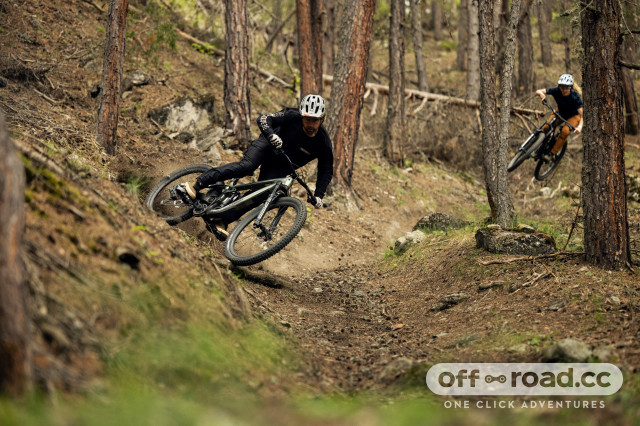
This year's Slash takes a departure from a full 29-inch wheel setup and, instead, goes for a mixed wheel size with a 29-inch front wheel and a 27.5-inch (650b) wheel at the rear. Trek has chosen this route as it believes that the big front will help roll over obstacles better while the little rear wheel increases clearance over the back of the bike and retains agility.
However, riders can run full 29-inch setups thanks to an interchangeable bolt-on lower shock bracket. The small frame size is 27.5-inch at both ends for easier handling for smaller riders.
However, unlike bikes from other brands, the small frame comes with few compromises as Trek states that it'll fit up to a 170mm dropper post with 290mm insertion, 85mm than before. This size also gets downtube storage and space for a water bottle in the front triangle.
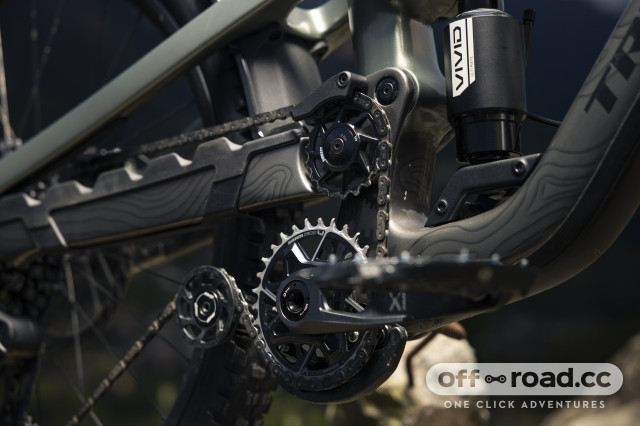
The elephant in the room is that the Slash has gone with a high-pivot suspension layout on this bike, which allows the rear axle to move rearwards with the force of bumps. This means that the rear wheel shouldn't hang up on square hits, resulting in better retention of momentum.
As a result, the Slash gets not one but two idler pulleys with the upper being oversized and featuring 19 teeth. Trek reckons that this size is more efficient and its placement reduces pedal kickback that's caused by chain growth – a defining factor of Aaron Gwin's famous chainless win.
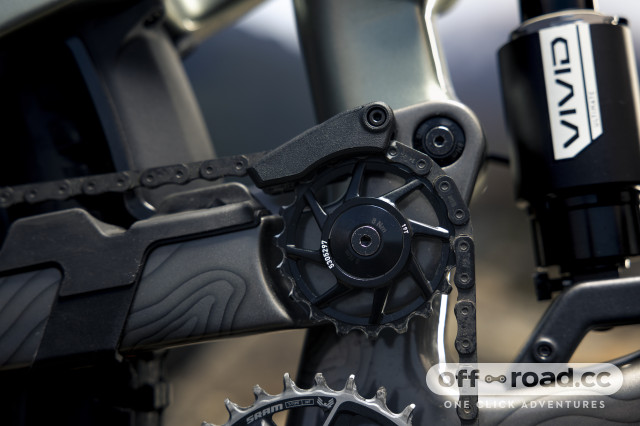
The lower idler then helps mitigate chain growth from under the chainstay, while keeping the chain from tugging on the derailleur cage.
As expected from a Trek bike, this one gets the brand's Active Braking Pivot tech which has been added to keep the Slash's suspension active when under braking. It's also said that this system has allowed the bike's designers to tune anti-squat and anti-rise independently. And speaking of anti-squat, Trek claims that it sits just above 100% throughout the travel range, which should lead to some mighty efficient pedalling.
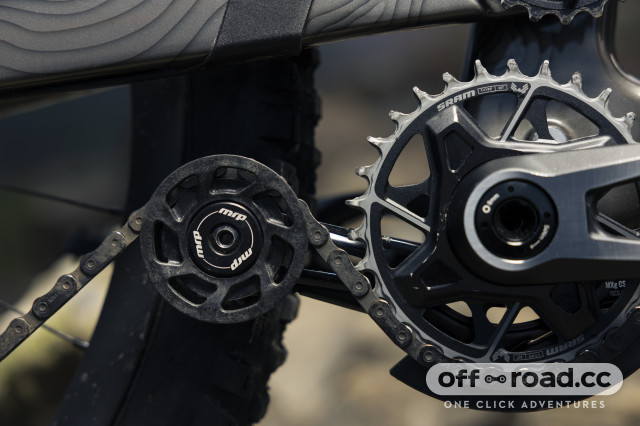
Elsewhere on the bike is a host of cool features, including a rear fender that's been designed specifically for this bike but it has to be removed if running a 29-inch rear wheel as there's not enough space. The Slash benefits from dual-density downtube guards that can be replaced if badly damaged.
On top of those guards, there is an impact-resistant film underneath the paint for even more protection.
At the rear, there's a chainstay guard that's been designed to reduce noise and, at the downtube, there's storage as expected of the Slash. However, this time, it's cut with a larger opening and its latch is easier to reach, says the brand. All of the plastic gubbins are made from recycled plastic, too.
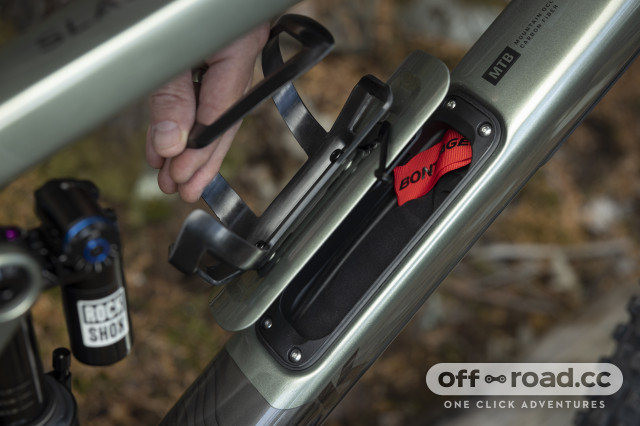
The 2023 Trek Slash lineup consists of nine builds with one alloy frame only –the balance is all carbon fibre. Throughout these builds, customers can expect Shimano XT to XTR cable actuated shifting, SRAM GX AXS through to XX AXS T-Type drivetrains. There's also a choice of Fox and RockShox suspension.
There are five sizes available from S up to XL and prices start at £4,250 for the Slash 8 and go up to £11,750 for the range-topping 9.9 XX AXS T-Type.
- www.trekbikes.com
You might also like:
- Are flat pedals worth it?
- Cross-country mountain bikes: understanding their design
- Buyer's guide to hydration packs for mountain biking
Author block

Liam Mercer
Tech Editor here at off.road.cc Liam can also be found photographing bikes as well as revelling in cycling's intricacies. Whether it's gravel, mountain, or e-MTB as long as it's a bike on dirt, he's happy.
Find great off-road deals
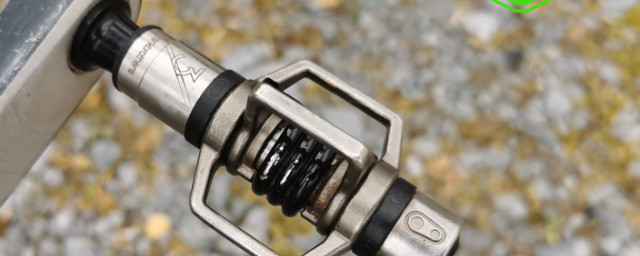

FIRST LOOK - The All-New High-Pivot Trek Slash 2
Redesigned from the ground up, trek's enduro model now features a high-pivot suspension design with an idler pulley, more travel, and loads of adjustability..
The sixth generation Slash focuses on enduro racers, park riders, and all-mountain rippers who want to ride aggressive terrain with the ability to pedal back to the top. The bike sees many changes from its predecessor, most notably a high-pivot suspension design that increases rear wheel travel up to 170mm. The Slash now rolls on mixed wheels in the stock configuration with full 29-inch compatibility on sizes Medium-XL. Size small frames feature 27.5-inch wheels front and rear only with a curved top tube for lower standover height. All frame sizes have size-specific chainstay lengths and seat tube angles to maintain a consistent fit across all sizes.
- All-new frame with high-pivot suspension
- Updated, slacker geometry with optional angle adjust headset cups
- Increased rear travel from 160mm to 170mm
- Leverage rate adjust chip
- Stock mixed-wheel builds on all sizes except size small (27.5” front and rear)
- Updated frame protection with Integrated Carbon Amor and a noise-reducing chainstay guard
- Room for longer dropper posts
- ISCG 05, 3-bolt tabs
- 2.5-inch maximum tire width
- BSA 73mm, threaded bottom bracket
- 200mm post mount rear, 220mm max rotor size
- MSRP: $4,399 - $11,499 USD

Still centered around Trek's ABP (Active Braking Pivot), the high pivot suspension design includes a large upper idler pulley and a new lower idler pulley. Similar to what would typically be found on a chain guide for chain retention, this lower idler pulley helps mitigate chain growth. Trek claims this prevents the suspension from fighting the derailleur clutch and allows for smoother drivetrain performance by preventing the derailleur cage from being pulled throughout the travel of the rear wheel.

While aggressive descents are where the Slash is meant to shine, Trek wanted to ensure the bike still pedals well. All frame sizes utilize a 77-degree effective seat tube angle to put riders in a relaxed and upright position. By strategically placing the 19t upper idler pulley, Trek increased anti-squat values exponentially over the previous generation Slash to create the best pedaling platform possible from the new design.

Regarding frame protection, the chainstay protector has a unique cupped shape to prevent any side-to-side movement and, from a side profile, creates the illusion that the chain is sitting directly on top of the chainstay. Downtube protection is handled by replaceable, dual-density guards that bolt into place. Beneath that, Trek has gone a step further and utilized a layer of thermoplastic beneath the paint to help prevent permanent frame damage from rock strikes to the downtube. All frames feature an integrated rear fender that mimics those on suspension forks, downtube storage with a larger opening for easier access, and an updated latch that is now easier to reach beneath a bottle cage.

In terms of adjustability, the new Slash incorporates an angle-adjust headset to allow for +/- 1 degree of head tube angle adjustment independent of bottom bracket height. This also means the infamous KnockBlock headset is no longer used and allows full rotation of the steer tube. Bolt-on lower shock mounts allow for either 27.5" or 29" rear wheels to keep geometry in check and feature a flip chip to adjust the progressivity of the leverage ratio, similar to what is found on the Session. Max allowable fork travel is 190mm up front with no dual crown compatibility from Trek officially.

The Slash is available as an aluminum or carbon frameset and in seven different build kit options for complete bikes. Top-of-the-line kits are spec'd at the 9.9 level with either SRAM XX and X0 T-Type options or full Shimano XTR, all with RockShox Ultimate level suspension. Build kits for 9.8 models are available with a GX AXS T-Type option or Shimano XT and RockShox Select+ level suspension. Aluminum Slash options include the Slash 9 spec'd with SRAM GX AXS (non-T-Type), a RockShox Zeb, and Vivid Select+, and the Slash 8 with Shimano XT drivetrain, a Fox Performance 38 fork, and Float X shock.

For more information, please visit trekbikes.com
View key specs, compare bikes, and rate the new Trek Slash in the Vital MTB Product Guide.
Stay tuned for our full review and comparison in our upcoming Enduro Bike Test Sessions!
- How does the adjustable headset work?
You can swap out your headset cups to get a full degree of head angle adjustment. The bikes come with neutral/zero-degree cups; consult the service manual to find part numbers to order the angle-adjust headset cups. The upper cup is a drop-in part, but the lower cup needs to be pressed in with a standard shop headset press. The cups have notches and laser-engraved guides to help you install them straight. For more detailed installation instructions, watch the Slash Service Tips video on Trek U.
- That oversized lower idler pulley is sick. Can I use it on the high pivot Session?
Yes! Consult the Slash service manual for part numbers.
- What is the maximum fork axle-to-crown and travel?
Carbon and Alloy: 190mm max travel (all sizes), 587mm A2C (size S), 606mm A2C (size M-XL)
- Is it compatible with dual crown forks?
They will fit, but we haven’t tested them, so we cannot recommend a dual crown fork on Slash at this time. However, you can put a 190mm single-crown fork on there, and that’s pretty close, and has a better turning radius.
- How much dropper post-insertion does the frame have?
Carbon frame max insertion (mm): S (290), M (305), ML (325), L (340), XL (370)
Alloy frame max insertion (mm): S (295), M (305), ML (325), L (340), XL (370)
- Which aftermarket shocks are compatible?
We know that the following shocks will fit. Other shocks may fit but should be checked for frame clearance at full suspension compression.
- RockShox Super Deluxe coil RockShox Super Deluxe AXS RockShox Next Gen Air (Vivid 2) Fox Live Valve NEO
- Fox X2 (MY21+)
- What size hardware is needed for aftermarket shocks?
Slash takes a 230mm x 65mm shock with an industry standard 54mm x 10mm upper and 20mm x 8mm lower standard pin mount.
- What is the maximum chainring size? Minimum chainring size?
Min: 28T, Max: 34T round, 32T oval
- What is the chain line?
- Does the new high-pivot layout require a longer chain?
Most sizes require a 126-link chain, which is a standard un-cut chain. XL requires 128 links.
View replies to: FIRST LOOK - The All-New High-Pivot Trek Slash


Most Popular

Hello Vital MTB Visitor,
We’re conducting a survey and would appreciate your input. Your answers will help Vital and the MTB industry better understand what riders like you want. Survey results will be used to recognize top brands. Make your voice heard!
Five lucky people will be selected at random to win a Vital MTB t-shirt.
Thanks in advance,
The Vital MTB Crew
your basket is empty

Trek 2024 Slash Chainstay Armor
SKU: W5306300
Only 0 in stock!
Recently viewed
- MAGAZINE OFFERS
- BIKE INSURANCE
- Best Products
- Maintenance
- Accessories
- Long-Term Reviews
- BikeRadar Podcast
- First Look Friday
- Bike of the Week
- Tech Features
- Routes and Rides
- Bike Galleries
- BikeRadar Bargains
- Buyer's Guides
- Fitness & Training
- Sizing & Fit
- Mountain Biking UK
- Cycling Plus
- Bike of the Year 2024
Trek Slash 8 Gen 6 review | Enduro Bike of the Year contender
Trek’s high-pivot, big-travel Slash 8 boasts good value and promises a lot on the trail
Laurence Crossman-Emms / Our Media
Robin Weaver
Composed feel at speed; climbs really well; great geometry; shock tunes helps it feel lively and playful; solid spec for the money
Tyres struggle in mud and aren’t tough enough; fork requires careful tuning to compensate for performance limitations
Trek has historically done well in our Enduro Bike of the Year category, with the Slash taking top honours back in 2021.
The latest Slash Gen 6 frames feature a high-pivot suspension design to deliver the 170mm of rear-wheel travel, come with a mixed-wheel setup as standard and offer up plenty of suspension and geometry adjustment.
On top of that, the new Slash also gets the standard lower, longer and slacker treatment in a bid to make this a genuine World enduro race winner.
The Slash 8 is the cheapest of the seven-bike Gen 6 line-up, uses an aluminium frame and comes with some solid parts from the likes of Shimano and Fox.
Although it's the cheapest of the eight bikes in my Enduro Bike of the Year test, it really packs a punch on the trail, with a ride that stands out for all the right reasons.
It’s sprightlier than expected and more playful too, but get stuck into the really rough stuff and it’s impressive just how well the rear end smooths out the trail.
Push too hard, though, and some of the spec choices start to hold this otherwise impressive rig back.
Trek Slash 8 Gen 6 frame and suspension details

The Slash 8 Gen 6 is made from Trek’s Alpha Platinum Aluminium, sports a plethora of rubberised driveside frame protection to help quieten chain slap and has under-belly guards to fend off rock strikes.
High-pivot designs are nothing new to Trek (the Diesel downhill bike was released more than 20 years ago), though they tend not to feature on bikes that need to be pedalled a lot.
That’s all changed with the latest Slash Gen 6 frame, which – you guessed it – now sports a high main pivot.
The bike continues to use Trek’s ABP (Active Braking Pivot) suspension layout, which sees the chain and seatstay pivot concentric to the rear wheel axle. That equates to a single pivot with a linkage-actuated rear shock.
The high main pivot creates a rearward axle path, designed to deal better with momentum killing square-edge hits.

In total, Trek says this moves a maximum of 18mm back from its starting point (growing the effective chainstay measurement) at around 135mm into the 170mm of rear-wheel travel before continuing to arc upwards and forwards for the remainder.
With 30 per cent sag, it’s estimated that the effective chainstay length will have increased by 11mm, sitting at around 440mm.
A massive upper idler helps to mitigate pedal kickback – a result of the rearward axle movement.
The lower idler cog is designed to take tension off the rear derailleur. This is not only to help it continue to shift properly and more efficiently, but to increase suspension sensitivity (because the lower section of the chain isn’t trying to extend the derailleur against its clutch mechanism).

Sizes small through to large need a standard 126-link chain, while the XL requires an extra-long 128-link chain.
To ensure the Slash Gen 6 can work with a coil-sprung shock , there’s a flip chip in the lower shock mount that enables you to increase the level of progression across the 170mm of travel from 20 to 25 per cent.
There’s also some integrated down tube storage for stashing essentials out of the way.
Trek Slash 8 Gen 6 geometry details

Trek offers the Slash Gen 6 in small, medium, medium/large, large and extra-large sizes.
The size small comes with 27.5in wheel front and back, while all other sizes use a 29in front and 27.5in rear wheel as standard.
There’s the option to switch to a larger rear wheel, although you’ll need to purchase a different lower shock mount to do so (£29.99).
Likewise, if you’re keen on altering the head angle, Trek sells aftermarket angled headset cups (plus or minus 1 degree) for £27.49.
I measured the Slash 8 to sport a slack head angle of 63.4 degrees, with a front centre of 790mm.
The seat tube angle is steep at 77.7 degrees, and the effective top tube quite compact for a size medium at 578mm.
Reach isn’t the longest at 448mm, but thanks to the compact seat tube lengths (400mm on the medium) across the size range, many riders will be able to size up if they’re looking for a roomier ride.
On paper, the Slash’s chainstay length looks really short at 429mm, but remember, as the bike drops through its travel, the rear axle moves backwards, effectively increasing this figure.
Trek Slash 8 Gen 6 specification

Trek has been smart with where it has spent the budget on the Slash 8.
Shimano XT gearing is great to see on this level of bike, and it’s no issue that this has been made possible in part thanks to the use of the lower-spec Deore crankset.
The brakes are also from Shimano, in the shape of Deore M6100 levers and four-piston M6120 calipers.
Taking care of the 170mm of travel at the front is a Fox 36 Rhythm fork, which uses the brand’s cheapest and most simplistic GRIP damper with limited adjustment compared to the pricier GRIP2 equivalent found on more expensive mountain bike forks .

This is matched to a Float X Performance rear shock.
In-house parts brand, Bontrager takes care of just about everything else, including the bar and stem. Unlike the pricier Slash 9.9 X0 AXS T-Type , it doesn’t use Trek's one-piece bar and stem, which is a plus in my eyes.
Bontrager also provides the wheels and XR5 Team Issue tyres.
All in, the medium Slash 8 Gen 6 on test weighed 17.01kg without pedals.
Trek Slash 8 Gen 6 ride impressions

I tested the Slash 8 on a wide variety of trails dotted around the Forest of Dean, South Wales and BikePark Wales.
These spanned from flowy jump lines through to hand-cut, steep, technical, natural descents, along with plenty of high-speed, rough-and-ready bike park tracks thrown in for good measure.
This enabled me to develop a thorough understanding of what the Slash 8 is good at and where it struggles.
Trek Slash 8 Gen 6 setup

Setup was quite straightforward, settling on 30 per cent sag for my 68kg weight with 147psi in the spring and the rebound damping left fully open. However, the fork became more of a puzzle as time progressed.
Initially, I settled on 71psi in the fork’s air spring, with only a couple of clicks of rebound damping wound on (from fully open). This offered masses of comfort and a decent level of traction.
As time went by and I felt more comfortable on the Trek, I had to increase the spring pressure and rebound damping to try to raise the level of support on offer.
I finished with 75.5psi in the air spring and no volume spacers.
Trek Slash 8 Gen 6 climbing performance

The Trek’s seated position is upright and comfortable, thanks to the steep seat tube angle.
It’s not particularly stretched out, though, due to the relatively short effective top tube and stumpy 35mm stem.
I wasn’t ever uncomfortable and didn’t feel cramped, but I noticed that compact position occasionally when scaling steeper, technical inclines. At 172cm, I think I could comfortably go up a frame size and negate these issues, though.
However, that’s not the headline here. What takes all the attention is how well this long-travel big hitter pedals.

Get cranking and the rear shock stays spookily still while you tick off the vertical metres. It helps that the tyres roll pretty quickly, too, limiting drag and injecting a bit of get up and go into proceedings.
With so little movement from the back end, you can leave the shock’s low-speed compression lever well alone because you don’t need it.
On every climb I tried, the Slash 8 felt the sprightliest and most energetic when pointed uphill, which is quite surprising considering its weight. It’s only when faced with soft mud that progress is stifled, due to the rear tyre lacking enough bite to generate grip and spinning up easier than others.
Trek Slash 8 Gen 6 descending performance

That energetic feel translates instantly to the trail when descending, too.
Trek has nailed the rear shock tune with this bike, producing a seriously capable bump gulper that helps generate traction when needed, but never sucks the fun out of even the tamest of tracks.
The fast-rolling tyres play a part in all of this, but the comfortable, well-balanced suspension helps the Slash remain playful, agile and, most importantly, fun when skimming through undulations and gapping rollers.
Speed seems to come easily, even when boosting in and out of slow-paced turns. Pick-up from the rear hub is quick and dumping gears quickly thanks to the precise XT shifter and derailleur is rapid when you find yourself wanting to inject even more speed to proceedings.
Square-edge what?

Pummel into faster, rougher sections of trail and the back end of the Slash really starts to shine.
The high-pivot design does a great job of scalping the peaks of the ugliest square-edge hits, helping you to stay online and composed at speed.
It’s this sensation that builds confidence and encourages you to ride faster. However, this is when you’ll start to reach the limits of the fork and tyres.

The Fox 36 Rhythm fork, with its GRIP damper, is one of the comfiest suspension forks on the market. But push it hard and you’ll be left puzzling over how to best balance that comfort with support.
My initial starting point delivered a beautifully supple ride, but lacked support when riding faster tracks, causing the front end to drop away with higher-load compressions and landings, and upsetting overall balance.
Upping the spring pressure and adding volume spacers helps here, but reduces overall comfort. The basic compression dial doesn’t exactly enable fine-tuning.
To unlock the full potential of the Slash 8, you’d be best to get the fork professionally tuned (roughly £120 for a service, plus £50 for custom tuning) so it can better handle being ridden hard without compromising that impressive comfort too much.

Similarly, I found myself incrementally adding pressure to the tyres , too, because they’re not as supportive or as tough as the best mountain bike tyres . This was largely because I found myself burping the rear tyre all too easily.
Thanks to the supple suspension, I didn’t find this to impact comfort too much, but you can feel the effects in terms of traction, especially when tackling anything remotely wet.
Swapping to your preferred tyre combo from the get-go should be high on your to-do list. You might want to ditch the chunky, wide-diameter grips while you’re at it.
Mega momentum

Despite those niggles, I never failed to have fun riding the Slash 8 and was always impressed by how well it could maintain speed.
On rough, high-speed tracks littered with rocks ready to sap your speed, the Trek always managed to retain incredible pace.
The back end beavers away tirelessly to isolate you from the worst impacts, enabling you to remain centred on the bike and focused on your line.

When speed started to dwindle, I had sufficient support, enabling me to pump undulations and compression in a bid to boost speed. However, I’d argue the Slash isn’t as direct and punchy in that sense as some of its rivals.
The geometry isn’t as lengthy or as raked out as some, but it still feels a confident bike to ride, even more so if you swap to grippier tyres.
Through the turns, the low 340mm bottom bracket helps to keep things suitably stable, while the suspension tracks the terrain almost effortlessly.
How does the Trek Slash 8 Gen 6 compare?

As the second most expensive bike within the Enduro Bike of the Year test, I’m going to compare the Slash 8 to the Transition Spire Alloy NX.
The Spire costs £50 more and comes with the same rear shock and a Marzocchi Z1 fork with the same GRIP damper.
But while the Slash features pricier Shimano XT gearing, the Spire has SRAM’s NX Eagle transmission. This proved to be clunkier and more problematic to keep running smoothly after months of riding in grim conditions.
The Spire suffers from the same fork issues as the Slash – impressive comfort but lacking in high-speed support when you really start pushing the bike.
Both bikes climb well, but the Slash feels a little punchier when grinding its way uphill.
On the descents, while the Spire offers a smooth ride, it can’t quite compete with the supple high-pivot bump-eating back end of the Slash.
The Slash is, overall, a comfier ride, too, with more feedback coming through the front end of the Spire when battering through repeated hits.
Enduro Bike of the Year 2024 | How we tested
The expectations resting on the shoulders of any enduro bike couldn’t be heavier. Creating a bike capable of tackling just about any trail revolves around smart choices and compromise.
In the simplest terms, enduro riding and racing is all about winching your way up to the top of a hill or mountain, then tackling an often-challenging descent.
These bikes are designed to excel at downhills.
How a bike handles the climb isn’t the be-all and end-all when it comes to overall performance, but pedalling efficiency and seated geometry still need to be factored in.
When it comes to geometry, we’re looking for stability and composure, but without dulling playfulness and agility.
A balanced suspension system creates a stable ride, but engineers also need to factor in the right amount of support for the rider to push against when pumping the terrain, and enough sensitivity to ensure the tyres can maximise traction on just about any surface.
Over a three-month period, all the bikes in this category were ridden back-to-back, as well as in different orders, in a bid to eke out every difference between them.
The trails in question varied from steep, natural downhill tracks and forest singletrack through to the high speeds and hefty impacts of BikePark Wales.
Our Enduro Bike of the Year contenders
- Santa Cruz Megatower C R
- Transition Spire Alloy NX
- Ibis HD6 XT
- Kona Process X CR
- Marin Alpine Trail XR
- YT Capra 29 Core 4
- Cube Stereo One77 C:68X TM 29
- Trek Slash 8 Gen 6
Trek Slash 8 Gen 6 bottom line

The Trek is a seriously smooth operator and really impressive for the cash.
Supple, well-balanced suspension and some really solid gear choices make it a formidable bike on the hills.
The fact that it has so much travel and a high-pivot, but climbs like a much lighter, shorter-travel machine is a massive bonus.
Push hard and the fork can’t keep up with the shock – and lacks the same level of composure at really high speeds. Meanwhile, the tyres are best suited to trail-centre pootling rather than full-on enduro riding and racing.
Swap the tyres and get the fork tuned to optimise performance and the Slash 8 Gen 6 will be an absolute rocket ship on the toughest of trails.
Share this article

Technical editor-in-chief
You may also like
Bikeradar newsfeed, vitus sommet 297 amp review, yt capra 29 core 4 review, merida one-sixty 6000 review, giant reign 1 review.

- Terms & Conditions
- Subscribe to our magazines
- Manage preferences
Pskov Oblast

- 2 Other destinations
- 3 Understand
- 6 Get around
- 11 Stay safe
Pskov Oblast is in Northwestern Russia , which borders Latvia to the west, Estonia to the northwest, Leningrad Oblast to the north, Novgorod Oblast to the northeast, Tver Oblast to the east, Smolensk Oblast to the southeast, and Belarus to the south.
Cities [ edit ]

- 57.816667 28.333333 1 Pskov — the ancient capital is not well prepared for tourism, but is rich in sites; its Krom (medieval citadel) is very impressive, it is circled by monasteries—including one which is Russia's oldest, and the city is full of small, old churches

Other destinations [ edit ]
- 57.016667 28.916667 1 Pushkinskie Gory (Pushkin Hills) - a former Pushkin's mansion and its surroundings converted into a large open-air museum with breathtaking scenery and traditional Russian ethnic elements. An excellent weekend destination.
Understand [ edit ]
Despite the proximity of the border with Latvia , Estonia and Belarus , in socio-economic terms, the Pskov Oblast is the most underdeveloped among all the Oblasts of Russia (only among the Oblasts), and the most backward region of Central Russia. There is practically no industry here, and agriculture is poorly developed.
An ancient region of Russia which once constituted its own republic, Pskov Oblast is a great weekend trip or longer from Saint Petersburg . Tourist infrastructure is at best rudimentary, although one would expect this will change in the near future, but the region has lots to see for an adventurous traveler or a traveler with a good guide. Pskov, the capital, is without a doubt the principal attraction and likely the only stop for most travelers, but it might be a good plan to get out of the city and check out nearby Izborsk.
Talk [ edit ]
See Russian phrasebook .
Get in [ edit ]
Two daily buses depart for Pskov from Novgorod at 08:30 and 16:00.
Trains from Saint Petersburg are unfortunately very inconvenient—they leave around 03:00 and arrive in Pskov four hours later. A better option is to hop on a bus from Petersburg's Vitebsky Vokzal; there are 15 buses bound for Pskov daily and they take about 5 hours to get there.
There is a daily overnight train from Moscow which leaves around 20:00 and arrives in Pskov around 08:00.
Pskov Airport ( PKV IATA ) from Moscow and Sochi.
Get around [ edit ]
See [ edit ], do [ edit ], eat [ edit ], drink [ edit ], stay safe [ edit ], go next [ edit ].
Pskov is a common last stop in Russia for visitors traveling overland to the Baltic states .
- Has custom banner
- Has mapframe
- Has map markers
- Outline regions
- Outline articles
- Region articles
- Bottom-level regions
- Has Geo parameter
- Northwestern Russia
- All destination articles
- Pages with maps
Navigation menu
- Trek 2021 Slash Carbon Chainstay Armor
We'll take care of you. Period.
It's our mission to provide you with world-class hospitality every time you visit us online or in-store. We're always here to help you. It's the Trek way.
30 Day Unconditional Guarantee
Ride it and love it, or we'll take it back. If for any reason you're not 100% happy with your trekbikes.com purchase, you can send it back within 30 days for a refund - no questions asked.
Free shipping on all orders over $49
Simple, free delivery options for however you prefer to shop. Orders over $49 ship to your home for free, and all orders ship free to your local retailer for in-store pickup
All your favorites, all in one place
Get all your favorite apparel from over 80 of the world's best cycling brands delivered right to your doorstep or local Trek retailer when you shop our curated online collection. If you're not 100% satisfied, you can return your purchase within 30 days for a full refund.
- Manage Account
Slash Recruits Iggy Pop, Steven Tyler & More For ‘Orgy of the Damned’: ‘I’m a Blues Guy’
Slash returns to his youthful roots on the all-star blues album.
By Gary Graff
- Share this article on Facebook
- Share this article on Twitter
- Share this article on Flipboard
- Share this article on Pinit
- + additional share options added
- Share this article on Reddit
- Share this article on Linkedin
- Share this article on Whatsapp
- Share this article on Email
- Print this article
- Share this article on Comment
- Share this article on Tumblr

Slash has the blues these days. And he’s happy about it.
Orgy of the Damned, the Guns N’ Roses guitarist’s new solo album (out Friday, May 17 on Gibson Records), is a set comprised mostly of blues covers and filled with A-list guests — Aerosmith’s Steven Tyler, ZZ Top’s Billy Gibbons, Demi Lovato, Chris Stapleton, Gary Clark, Jr., Iggy Pop, the Black Crowes’ Chris Robinson and AC/DC’s Brian Johnson, to name a few.
Two Songs Top 70 Million Weekly U.S. Streams for the First Time
See latest videos, charts and news
Guns ‘N Roses
Trending on billboard.
“But I’ve always thought, ‘God, it would be cool to do a record like this,’ sort of a just-for-fun kind of f***-around thing. But I never really had time to do something like that.”
During the past couple of years, however, Slash says he’s “been listening to a lot of old blues record and blues guitar playing and I still wanted to do that kind of album. It’s just something fun that I really needed to get off my chest, and I wanted to have a good time with it.”
Slash’s longtime manager Jeff Varner of Revelation Management adds that timing proved to be fortuitous for Orgy of the Damned as well as for the 29-date S.E.R.P.E.N.T. Blues Festival tour; Slash embarks July 5 in Bonner, Montana. “Prior to last year we were mapping out the next 24 months and this idea came up again,” Varner recalls. “He said, ‘I’m thinking about doing a blues record,’ and I said, ‘Funny, I’ve been thinking about doing that, making a tour property around it.’ It was a serendipitous moment of, ‘OK…’ Obviously he leads the charge, but we felt like there’s a real opportunity here and now’s a good time to do it.”
“I never wanted it to be taken too seriously and have it be this serious blues record like people are putting out these days,” explains Slash, whose sole original on Orgy of the Damned is the closing instrumental “Metal Chestnut.” “Most good musicians have a certain amount of integrity, so you take it seriously in that context but at the same time it was really just fun. I think that’s one of the reasons why the idea of having different singers was born, so as to keep it from being a ‘serious’ blues record.”
It’s not the first time Slash has taken the all-star approach, of course; his self-titled 2010 effort also featured a diverse roster of guest vocalists (Ozzy Osbourne, Dave Grohl and the Cult’s Ian Asbury to Fergie and Maroon 5’s Adam Levin). It also included Myles Kennedy and provided the impetus for the Conspirators band, which has released four studio albums. For Orgy of the Damned, Slash says he “picked the song first and just thought about who would sound good doing that song. The key thing for any of them was if the person I thought of related to the song and had any kind of history with it — if it meant something to them. That was the criteria for actually going forth and recording it.
“Fortunately for pretty much everybody on the record, the song they’re on really had some deep meaning to them or they really loved it or it had an influence on them.”
Nowhere was that more true than on the acoustic rendering of Hopkin’s “Awful Dream” with Pop, who had also appeared on a track for the Slash album. “I read that Iggy had always wanted to do a blues record or project or whatever and I gave him a call,” Slash remembers. “I talked to him and he said that he’s never had the opportunity to do a blues thing. So I asked him, ‘If you were gonna do a blues song, which song would you do?’ and without missing a beat he said ‘Awful Dream,’ and there was something in the way he said it that sounded like it was really special to him.
That’s just one of many magical music moments on Orgy of the Damned. Slash goes toe-to-toe with Clark Jr. on Robert Johnson’s “Crossroads” (closer to Cream’s reimagination than the original “Crossroad Blues”) and with Gibbons on Dixon’s “Hoochie Coochie Man.” AC/DC’s Johnson was Slash’s first choice for Howlin’ Wolf’s “Killing Floor,” and Tyler on harmonica was a bonus. “We were talking one day and I told him what we were doing and he offered to play harmonica on it — and came down that same day. It was a good hang.” Lovato’s appearance on “Papa Was a Rolling Stone” may surprise some, but not in the wake of the rock direction of her own recent music.
“People don’t think of her in that capacity, but she’s absolutely amazing on it…and it’s cool to see her in a little bit of a different light,” manager Varner notes.
“All the songs are songs I was influenced by from when I was really little, up until recently,” says Slash, who used the album to explore different aspects of his playing technique. “In the various bands I’ve been involved in there’s a lot of improvising and stuff that goes on but they’re bands with very defined songs and arrangements and stuff,” he explains. “I go out and jam a lot with different club bands that will let me sit in all over the country, if not all over the world, just ’cause I happen to be in the neighborhood, and you get to play with some really good players that have a nice, greasy feel. There’s something about that that you don’t get to do in the bands.
The S.E.R.P.E.N.T. tour (Solidarity, Engagement, Restore, Peace, Equality N’ Tolerance) was a logical outgrowth of Orgy of the Damned , meanwhile. The trek will include a rotating cast of guests including the Warren Haynes Band, Samantha fish, Eric Gales, Keb’ Mo’, Robert Randolph, ZZ Ward, Christone “Kingfish” Ingram, Larkin Poe and Jackie Venson, and Slash predicts that “there’s gonna be any number of different jams going on” during the dates.
Slash adds that he’s open to making more blues albums in the same manner as Orgy of the Damned, while Varner predicts that the S.E.R.P.E.N.T. tour could become a recurring theme in the future. “I think from our standpoint this is a fun project that’s pretty flexible and nimble,” he says. “I can definitely see doing more of the S.E.R.P.E.N.T. festival either here or in Europe, different versions of it. Our goal here is to create something that can be evergreen, something he can have as an additional outlet — not that he needs any more things on his plate.”
That’s a juggle Slash says he’s happy to maintain.
“It’s just fun for me,” he says. “As a player that’s really what I enjoy doing. So having all these different sorts of opportunities to be able to play and record and to go out on the road, I really relish it. Just having this different variety of things to do is healthy. It’s very motivating for me, inspiring.”
Get weekly rundowns straight to your inbox
Want to know what everyone in the music business is talking about?
Get in the know on.
Billboard is a part of Penske Media Corporation. © 2024 Billboard Media, LLC. All Rights Reserved.
optional screen reader
Charts expand charts menu.
- Billboard Hot 100™
- Billboard 200™
- Hits Of The World™
- TikTok Billboard Top 50
- Song Breaker
- Year-End Charts
- Decade-End Charts
Music Expand music menu
- R&B/Hip-Hop
Videos Expand videos menu
Culture expand culture menu, media expand media menu, business expand business menu.
- Business News
- Record Labels
- View All Pro
Pro Tools Expand pro-tools menu
- Songwriters & Producers
- Artist Index
- Royalty Calculator
- Market Watch
- Industry Events Calendar
Billboard Español Expand billboard-espanol menu
- Cultura y Entretenimiento
Get Up Anthems by Tres Expand get-up-anthems-by-tres menu
Honda music expand honda-music menu.
Star Trek: TNG's The Chase Was Already A Struggle – Then Its Budget Was Stolen By DS9

Practically speaking, there's a reason why most aliens on "Star Trek" are humanoid. Not only are they humanoid, but they all share very similar specific features: two legs, two arms, two eyes, one mouth, teeth, and/or hair. Many aliens look identical to humans apart from ridges on their foreheads or elaborate skin markings. This is because all the aliens on "Star Trek" are played by human actors. Very occasionally, Captain Kirk (William Shatner) might encounter a Melkot or a Tholian who were achieved through puppetry or photographic effects, but for the most part, aliens were played by Earth's boring ol' Homo sapiens actors.
By the time the "Star Trek: The Next Generation" episode "The Chase" aired on April 26, 1993, Trekkies had been watching the franchise long enough to ask why — from an in-canon perspective — all aliens looked like humans. "The Chase" came up with a cute (if not wholly satisfying) canonical excuse as to why Trek evolutionary biology favored human shapes: it seems all humanoid species share a common ancestor. As the lore goes: billions of years ago, the galaxy's first sentient species evolved on a distant planet. They explored the universe in ultra-high-speed space vessels but found no neighbors. To rectify the situation, they seeded millions of worlds with their DNA, assuring other species would evolve similarly in millions of years. It's not great, but it's something.
In the oral history book "Captains' Logs: The Unauthorized Complete Trek Voyages" edited by Mark A. Altman and Edward Gross, various NextGen showrunners admitted that "The Chase" was hard to hed a handle on, and that the script underwent many changes. Most damning was when "Star Trek: Deep Space Nine," running concurrently, siphoned a lot of NextGen's budget. A lot of cuts and concessions had to be made.
Deep Space Nine was too expensive
Longtime Trek executive producer Rick Berman noted that the script for "The Chase" had been kicked around the Paramount offices for years, with no writer able to unlock it or make the story work. Even when the script finally came together — ultimately credited to Ron D. Moore and Joe Menosky — it still didn't quite satisfy him. He said:
"It's a story that's been around forever. It was similar to 'Darmok,' which was a story that was around forever also. 'Darmok' never worked for me until Joe came up with the direction that he came up with ... and it turned out to be one of my favorite episodes of all time. This story did not. Conceptually, it's very interesting. I always had some problems with dealing with the whole idea of these kind of prehistoric creatures who are the fathers of us all. It's not Roddenberry-esque, it's very '60s Roddenberry-esque."
"Darmok" (September 30, 1991) is a beloved episode about an alien species, the Tamarians, who communicate exclusively through cultural metaphors. It's a great episode.
Executive producer Michael Piller noted that Menosky delved far too deeply into technobabble, saying, "You turn the page and it begins to go into the tech. One of the great talents of Menosky has always been his ability to see places the rest of us wouldn't even go to look and from page 20 to page 60 he was on a different plane, existing somewhere else." Piller repeatedly returned the script to Menosky saying "he didn't get it."
Even Ron D. Moore admits that he couldn't quite crack the story as what he originally envisioned would be too expensive to realize. And then, even after cutting it down, "Deep Space Nine" started sapping up money.
Jonathan Frakes directed The Chase
"The Chase" was directed by cast member Jonathan Frakes, and he was upset with the episode as well. He noted that the episode's finale, as seen in the above photo, had to be shot on a soundstage and not on location, and that it looked cheap. The finale involved a group of Klingons, a group of Romulans, a group of Cardassians, and several Starfleet officers gathering around to witness an impossibly ancient hologram of a humanoid progenitor (Salome Jens) explaining her species' need to seed millions of worlds. Frakes pointed out that Jens and several of the episode's guest aliens were terrific, especially John Cothran, Jr. as a Klingon and Maurice Roeves who played a Romulan. But, he added:
"I was very disappointed not to get to shoot outside. [...] I think it does look like Planet Hell, but that's the way it goes. The money was being spent across the street [at 'Deep Space Nine']. I don't think it's a secret."
"Planet Hell" was a nickname the Trek cast and crew gave to an often-reused indoor cave set that stood in for multiple alien worlds. The set infamously looks cheap and artificial and was never as convincing as an alien catacomb. It seems that if "Deep Space Nine" hadn't been in production at the same time; the new series premiered a few months earlier, and Paramount was clearly more concerned with their new baby than their old friend.
But then, maybe Planet Hell was the preferable option. Location shoots typically brought the "NextGen" crew to Topanga Canyon, Vasquez Rocks, or some other locale in Southern California ... and it always looks like Southern California. A fake set, at the very least, looked more alien.
Target Lowers Price on More Than 5,000 Items to Attract Shoppers On a Budget
By Anna Tingley
Anna Tingley
- ‘Dune: Part Two’ Is Now Streaming Online 2 hours ago
- Where to Watch Every ‘Mad Max’ Movie Online Ahead of ‘Furiosa’ 2 hours ago
- How to Watch ‘The Masked Singer’ Season 11 Finale Online 3 hours ago

If you purchase an independently reviewed product or service through a link on our website, Variety may receive an affiliate commission.
High prices? In this economy? As Lucille Bluth famously said in “Arrested Development, “I mean it’s one banana, Michael. What could it cost? Ten dollars?”
Even if she was more than a few dollars off, the point still stands. Prices have continued to skyrocket in the years since the pandemic began, and although inflation has slowed since its mid-2022 peak, it still remains above the pandemic average.
Popular on Variety
As of this writing, Target has officially cut prices on 1,500 items. So far, these price cuts make a slash through a variety of categories, including food staples such as frozen chicken and shredded cheese. More lowered prices are planned to go live throughout the summer. Items expected to see the steepest discounts, according to the retailer’s statement, include meat, bread, soda, fresh fruit, vegetables, snacks and yogurt.
In addition to these new discounts, Target will also boast hundreds of Memorial Day deals next weekend. In the meantime, shop through some of the best deals currently live on Target below:
Vizio D-Series 40-Inch LED Smart TV
Jbl clip 4 waterproof speaker, lenovo ideapad, amazon echo show 8, nespresso vertuo, fire tv stick, vizio v series 5.1 home theater sound bar system, more from our brands, kaytranada reveals tracklist, guests, date for his new album, why you should be snapping up neo-vintage watches—and how to start collecting them, tnt sports launches chat, data altcasts for nba, nhl playoffs, the best loofahs and body scrubbers, according to dermatologists, evil enlists anna chlumsky to befriend ‘grieving kristen’ in final season; nate corddry and christian borle also cast, verify it's you, please log in.

IMAGES
VIDEO
COMMENTS
Enhance your cycling experience with Trek 2021 Slash 29 Carbon Chainstay. Shop now!
17. Gibnos (Oct 30, 2023 at 8:48) Slash 9 owners review - The bike differs from what a "conventional" bike feels just enough to require an adaptation period. The upside is that it has an unreal ...
2024 Trek Slash — Chainstay Protection (photo: Trek Bikes / Sterling Lorence) 2024 Trek Slash — Downtube Storage. Trek was one of the first companies to offer in-frame storage on mountain bikes, and the new Slash continues the trend with a hatch under the water bottle mount on all frame sizes, in both the aluminum and carbon fiber frames. ...
• Size-specific chainstay length • Measured weight: 36.4lbs w/ pedals • $4,400-$11,500 USD ... the new Trek Slash now allows the end user to change the head angle of the frame by 1°, be it ...
The chainstay length remains the same across the board for all sizes, at 437mm in the low setting. ... Trek Slash= 76.1 degree STA but its ok to slide the seat forward and deal with it on the climbs
Brand: Trek, Product: 2021 Slash Alloy Chainstay Armor Keep your investment protected with durable armor designed specifically for your ride. - Protection engineered to keep your ride looking as good as new for years to come.
TREK SLASH GEN 6 REVIEW. There has been a Slash in Trek's arsenal for just over 10 years, and it has undergone five generations of upgrades coming into the end of the 2023 season. ... Our M/L-size test bike has a 434.2mm chainstay length, but Trek gives this bike size-specific chainstays to keep a consistent ride feel throughout the size ...
Vital Test Sessions - Trek Slash 9.9 X0 AXS T-Type 14 The ground up redesign featuring a high-pivot suspension design, more travel, and loads of adjustability make this Trek's most adaptable Slash yet. ... A gap of 10-24mm from the bottom of the chainstay to the top of the roller, depending on frame size and drivetrain, is what we advise. 6 ...
It's the Trek Slash 9.8 GX AXS, which sells for $10,499 AUD. Despite being the second cheapest model it still features a full carbon frame, high performance RockShox suspension and a wireless SRAM GX AXS Transmission, making it an appealing package. We reckon the Trek Slash 9.8 GX AXS is the pick of the 6-model lineup. 2024 Trek Slash 9.8 GX AXS
The lower idler then helps mitigate chain growth from under the chainstay, while keeping the chain from tugging on the derailleur cage. As expected from a Trek bike, this one gets the brand's Active Braking Pivot tech which has been added to keep the Slash's suspension active when under braking.
The sixth generation Slash focuses on enduro racers, park riders, and all-mountain rippers who want to ride aggressive terrain with the ability to pedal back to the top. The bike sees many changes from its predecessor, most notably a high-pivot suspension design that increases rear wheel travel up to 170mm. The Slash now rolls on mixed wheels in the stock configuration with full 29-inch ...
Trek Trek 2024 Slash Chainstay Armor. 0 opinion. SKU: W5306300. $16.99 CAD / Voir sur le site de Trek. To share. Couleur: Noir; Grandeur: One size; Amount: Sold out Opinion (0) Recently viewed. About Cycles Régis ...
My chainstay from my trek slash 2021 accidentally bent and now my pivots starting to make noise. The problem is I can't find a dealer who's able to deliver just the chainstay for my aluminium frame. What should I do? New bike new frame? I upgraded to a lyric ultimate and dtswiss rims (only the rim)
Trek Slash 8 Gen 6 review | Enduro Bike of the Year contender | BikeRadar.
Additionally, "Star Trek: Picard" executive producer Terry Matalas will serve as a showrunner of the "Vision" show. Vision, of course, was rebuilt as a proper synthezoid android by S.W.O.R.D. and ...
Pskov Oblast. / 57.317°N 29.250°E / 57.317; 29.250. Pskov Oblast ( Russian: Пско́вская о́бласть, romanized : Pskovskaya oblast') is a federal subject of Russia (an oblast ), located in the west of the country. Its administrative center is the city of Pskov. As of the 2021 Census, its population was 599,084.
Paramount. By Witney Seibold / May 21, 2024 3:39 pm EST. It was announced today in the Hollywood Reporter that Simon Kinberg is taking over the development of the new "Star Trek" feature film ...
File:Outline Map of Pskov Oblast.svg. Size of this PNG preview of this SVG file: 432 × 599 pixels. Other resolutions: 173 × 240 pixels | 346 × 480 pixels | 554 × 768 pixels | 738 × 1,024 pixels | 1,477 × 2,048 pixels | 512 × 710 pixels. This is a file from the Wikimedia Commons. Information from its description page there is shown below.
An ancient region of Russia which once constituted its own republic, Pskov Oblast is a great weekend trip or longer from Saint Petersburg. Tourist infrastructure is at best rudimentary, although one would expect this will change in the near future, but the region has lots to see for an adventurous traveler or a traveler with a good guide.
Beam us up, Holly Hunter. William Shatner. Patrick Stewart. Avery Brooks. Kate Mulgrew. Chris Pine. Anson Mount. Michelle Yeoh. We can now add Holly Hunter's name to the ranks of talented actors ...
Trek 2021 Slash Carbon Chainstay Armor; Trek 2021 Slash Carbon Chainstay Armor; We'll take care of you. Period. ... It's the Trek way. 30 Day Unconditional Guarantee. Ride it and love it, or we'll take it back. If for any reason you're not 100% happy with your trekbikes.com purchase, you can send it back within 30 days for a refund - no ...
Unexpectedly, Dr. McCoy (DeForest Kelley) runs through the portal — he's hopped up on drugs — and travels instantly to Earth in 1930. Kirk and Spock follow him to ensure he doesn't foul with ...
Slash has the blues these days. And he's happy about it. Orgy of the Damned, the Guns N' Roses guitarist's new solo album (out Friday, May 17 on Gibson Records), is a set comprised mostly of ...
As the lore goes: billions of years ago, the galaxy's first sentient species evolved on a distant planet. They explored the universe in ultra-high-speed space vessels but found no neighbors. To ...
New Zaplyuskaya narrow gauge railway (Pindstrup Mosebrug A/S) is a newly opened peat narrow gauge line in Plyussky District of Pskov Oblast, 10.07.2018....
Thankfully, Target has responded to this less-than-desirable trend by proactively lowering the prices on more than 5,000 of their most popular products in order to lure more shoppers into their ...